All things power boat racing...
- Propeller Magazine
- APBA Social
- Member Login
- Inboard Endurance
- Junior Classes
- Modified Outboard
- Outboard Drag
- Outboard Performance Craft
- PRO Outboard
- Special Events
- Stock Outboard
- Superlight Tunnels
- Vintage & Historic
- New to Racing?
- Race Schedule
- Submit a Sanction
- 2013 Champions
- 2016 Annual Meeting
- High Points
- Upcoming Region Meetings
- Race Results
- Start Your Own Race
- APBA Administration
- Contact APBA
- Speed Records
- Hall of Champions
- Honor Squadron
- APBA Sponsors
- Resource Directory
- Meeting Minutes
- Government Affairs
- Entry Blank
- Member Benefits
- Where to Buy
- Classifieds

Featured News
More headlines.
- AMERICAN POWER BOAT ASSOCIATION ANNOUNCES RESULTS FOR BOARD OF DIRECTORS
- Organizers gearing up for 16th Annual Quake on the Lake
- H1 Returning to Detroit Aug. 22-23
- Thunder on the Narrows marks 25th anniversary
- Battling back
- River Chase also making a splash in Rock Falls
- $12K Donated to Records And Regatta Challenge
- Capsule Training Helps Drivers Be Safer on the Water
- Phipps and Robertson to new teams
- Boat races returning to West Milford in spring
- H1 to work on Detroit race
- KNRA hosts Region 4 powerboat awards
- Power Boat Races Return to Huntington
- Proud father enjoys sons' powerboat success
- LISTEN LIVE! 2015 Marathon Nationals
- Bonney Lake's Kelly takes Oryx Cup battle; Covington's Shane captures series title
- Fast Starts Serve U.S. Well at World Championships
- Local jet boat river racers make waves
- Former pilot reduces cost, weight of hydroplanes with composites
- American Power Boat Association announces results for Board of Directors

FEATURED CLASSES
Explore APBA’s Featured Powerboat Racing Hulls
When you hear the roar of automotive engines and catch a glimpse of giant rooster tails, chances are pretty good that inboards are on the water. Inboard racing classes include both runabouts and hydroplanes that are fast, fun and LOUD. Classes span from wild Jersey Speed Skiffs (70mph) to supercharged 1,500 horsepower Grand Prix Hydroplanes (170 MPH). Inboard racing classes consist of both Runabout and Hydroplane classes. You can tell a boat’s class by the letter(s) next to the boat number.
APBA Offshore racing features some of the biggest and fastest boats around. These Mega-horsepower catamarans and V-hulls are capable of speeds up to 180 MPH. The teamwork and professionalism of Offshore racing make it a class act and a thrill for spectators. Typically, a team of one driver and one throttle man battle the wind and waves of the world's toughest race courses.
TUNNEL BOAT
Commonly known as tunnel boats, the hulls, built from composite materials or wood, are designed to ride on a cushion of air when the boat reaches plane. The racing craft is lifted just above the water by forcing air underneath the bottom and trapping it between the outside sponsons (think catamaran hull design). This surface-skimming ride and the incredible horsepower-to-speed ratio push Newton's fundamental law of gravity to the outer limits, giving the driver an unparalleled aerodynamic experience.
Hydros ride on a cushion of air; the boat contacts the water’s surface on two sponsons (projections) and the propeller. The design is generally unrestricted, challenging those who wish to experiment in boat design and construction.
Runabouts have certain restrictions, like minimum lengths. While there is great variety in runabout design, generally they have a flat riding surface, tapered to a point in front, and do not channel air under the hull.
V-Hull race boat hulls are specifically designed to deliver exceptional speed and agility on the water. These hulls feature a distinctive V-shape, characterized by a sharp entry point at the bow that gradually tapers to a narrower and flatter shape towards the stern. This unique design allows the boat to cut through the water with reduced resistance, resulting in enhanced performance.
A jet boat uses an onboard internal combustion engine to power a water pump, called a jet pump . This pump sucks in water from the lake, river, or sea and forces it out as a high-pressure stream through one or more nozzles. The water intake is typically at the front or center of the boat.
MotoSurf racing is known for its environmental friendly approach thanks to advanced technologies used in the motorized surfboards. The combustion engines categories race craft are designed according to latest technologies and the main manufacturer in the championship – JetSurf – is even CE and EPA certified and is officially classified as least emission personal water craft.
The electric powered category is raced on fully electric powered motorized surfboards with zero local emission impact. The electric powered category is the very first fully electric powered racing class in powerboating world.
2023 official sponsors

- Copyright 2023 American Power Boat Association
- All rights reserved.
- Design + Development with PRYDE
Last updated: Feb 09, 2024
What Is Powerboat Racing?
The sport of powerboat racing has been around for over 100 years with popularity worldwide. The powerboat, which can also be called a motorboat or speedboat, is powered by an engine which allows for high performance speeds. It is one of the most popular forms of boat racing, with multiple international events annually.
Table of Contents
Playing surface, powerboat racing equipment, rules and regulations, athletes and racers, events and competitions.
Powerboat racing competition was created in the early 1900s, with the first race taking place in 1904. The sport began to grow and led to the founding of the American Power Boat Association (APBA) which held its first U.S. event in 1911. Over the next 50 years powerboat racing became popular across the world, with increased organizations, races, and tournaments. Sports within powerboat racing have expanded as well, with organizations created to sanction specific types of racing.
Naturally, the overall playing surface for powerboat racing is water. That being said the two types of powerboat racing, inshore and offshore, come with slightly different racing conditions. Offshore powerboat racing takes place out on the open ocean hence the name “offshore” whereas inshore powerboat racing often takes place in smaller bodies of water like lakes. Be sure to take into account what race you’re looking to participate in, as it can have a substantial impact on the playing surface you’ll be racing on.
Powerboat racing is an exhilarating sport, but also carries a level of risk. That being said, there are a few basic essentials you’ll want to have handy regardless of what type of powerboat racing you plan on trying out. Each of these pieces of equipment are important to ensure you have the best and safest time powerboat racing possible.
Here is the essential powerboat racing equipment you should have:
- Close Toed Shoes
- Neck Restraint
At the end of the day, powerboat racing carries the same objective as any other racing sport: to finish the course the fastest. That being said, the distance and overall course in a powerboat race can change from venue to venue. Further, inshore and offshore powerboat racing each offer different course conditions. Be sure to read up on your local powerboat race’s course to be as prepared as possible, and ensure you have the best shot of winning the big race!
Powerboat racing is a serious sport that can carry serious consequences if rules designed to protect all drivers aren’t followed. There are extensive rulebooks for most major races, but here are some basics that should more or less hold true regardless of what race you’re looking to participate in.
Here are the most important powerboat racing rules you should know:
- Strict adherence to boat classes
- Compliance with pre race engine checks
- Safe and respectful passing maneuvers, giving space to boats riding the inner lane.
Powerboat racing carries certain terminology separate from any other boat racing sport, as well as some basic terminology for boat racing as a whole. There’s a multitude of terms out there, but some are far more widespread than others.
Here is the common lingo and slang in powerboat racing:
- Bow : The front end of any boat.
- Hull : The shell of a boat.
- Port : The left side of any boat.
- Starboard: The right side of any boat.
- Stern: The back end of any boat.
Powerboat racing athletes come from all over the world. They typically become more popular when they compete in large international competitions rather than just their home country. In some instances, 2 or more athletes compete as a racing team. We see this in events such as the F1H2O UIM World Championship.
Here are the most famous powerboat racing players you should know:
- Alex Carella
- Jonas Andersson
- Peter Morin
- Shaun Torrente
Powerboat Racing has multiple leagues and organizations that hold events around the world. They are typically governed by the official powerboat association of their respective country. Don’t be surprised to see large races that encompass different water sports, such as Inshore Powerboat Racing or Offshore Powerboat Racing.
Here are the most popular powerboat racing leagues you should know:
- National Boat Racing Association
- Super Boat International
- TCPBA Powerboat Racing
There are a multitude of powerboat racing events out there, however some are bigger than others. The top events in the world feature the best racers from across the globe, the biggest sponsors, and the most fanfare.
Here are the most popular powerboat racing tournaments you should know:
- F1 H2O UIM World Championship
- Offshore Superboat Championships
- UIM Class One World Powerboat Championship
- UIM F2 European Championship
- UIM H2O Nation's Cup
Pages Related to What Is Powerboat Racing?
- What is Boat Racing?
- Boat Racing
- What is Offshore Powerboat Racing?

- Subscribe Now
- Digital Editions

Top 10 powerboat racing icons that helped make boating what it is today
- Top stories
Hugo Peel explores the top ten power-boating events, people and inventions that have influenced today’s sportsboats...
Powerboat racing may seem a world away from the type of cruising most of us do but the sportsboats we enjoy today wouldn’t be half as good as they are without the racers, designers and builders whose heroic efforts helped shape them.
Auto-boat racing, as it was originally known, traces its history back to the late 19th century and for a brief period was even an Olympic sport, with races staged off the Isle of Wight in 1908. However, it wasn’t until the 1960s and 1970s that the sport exploded in popularity as developments in engineering, materials, speed, safety and propulsion really took off.
Racing was the anvil on which these promising technologies were forged. So what are the ten most significant events, inventions and people that have contributed to today’s impressive levels of performance, safety and utility?
While many of these names and events may be unfamiliar now, they are the stuff of legend to all who recall the glory days of British powerboat racing.
1. The Cowes-Torquay-Cowes offshore powerboat race
Many people regard offshore powerboat racing as the ultimate challenge for craft and crew. Arguably the most challenging race of all and certainly one of the oldest is the legendary Cowes-Torquay competition.
Initiated in 1961 by Daily Express newspaper magnate and keen yachtsman, Sir Max Aitken, who foresaw it would help grow the UK marine industry, it bred a string of British and international heroes and brands. This 200-mile race, now known as the Cowes-Torquay-Cowes, and its coveted Harmsworth Trophy, intermittently awarded since 1903, is still the one all top powerboat racers yearn to win.
The marathon Round Britain Powerboat Race started and finished off Portsmouth
2. The marathon Round Britain Powerboat Race
If a 200-mile race sounds challenging, the 1,500-mile endurance marathon that is the Round Britain Race is on an altogether different scale, yet it proved so appealing that it has been run three times over four decades.
The first BP-sponsored race in 1969 comprised ten stages over 1,459 miles and was won by Timo Mäkinen, a champion Finnish rally-driver in Avenger Too propelled by triple Mercury outboards – he averaged 37mph.
The 1984 race was sponsored by Everest double glazing and attracted famous names, including Italian racer/designer Fabio Buzzi driving White Iveco , a single-step GRP monohull with four 600bhp Iveco diesels. Against him was fellow Italian Renato della Valle in Ego Lamborghini , an aluminium-hull craft powered by two ear-splitting 800hp, race-tuned V12 Lamborghinis.
Article continues below…
Test driving the Sunseeker Hawk 38 prototype with Fabio Buzzi
Lamborghini boat: tecnomar delivers first official ‘fighting bull’ branded yacht.
Victory went to Buzzi who, after the 157-mile Dundee-Whitby leg, during which White Iveco averaged a staggering 69 knots, dismissed it with shrug saying: ‘In Italy, this is just a cruising boat.’
The race was revived in 2008 attracting a field of 47 raceboats old and new, including a number of production RIBs and sportsboats from companies like Scorpion , Goldfish and Scanner. The favourites included Fabio Buzzi again in his classic four-engined Red FPT , and Austrian casino millionaire Hannes Bohinc in another Buzzi-designed monohull Wettpunkt .
This time the overall winner was a Greek entry Blue FPT navigated by Britain’s Dag Pike, who at 75 years old, was the event’s oldest competitor. Many of the production boats also did remarkably well, showing just how far they have come in recent years.
Steve Curtis MBE is powerboat racing royalty
3. Powerboat racer Steve Curtis
If the Cowes-Torquay-Cowes is the benchmark, surely the top driver must be found among its winners? Home-grown contenders must include Tommy Sopwith, a winner in 1961, 1968 and 1970 and the Gardner brothers, Charles and Jimmy, who clocked up victories in 1964 with their Bertram 31 Surfrider , and again in 1967 in the iconic Sonny Levi-designed Surfury .
On the worldwide stage, Italy’s Renato Della Valle won four Cowes Torquay Cowes races in a row from 1982 to 1985. Hannes Bohinc collected the trophies in 1995 and 2003 and another German, Markus Hendricks, whose boat sank on the 2008 Round Britain, took a re-engined 34-year-old monohull, Cinzano , to victory in 2009 and 2011.
They are all brilliant in their way but how could this category ignore the UK’s Steve Curtis MBE, owner of Cougar Marine, with no fewer than eight Class One powerboat racing world championships in fearsome 175mph catamarans? Curtis’s 2016 victory in the roughest ever Cowes Torquay Cowes race, in a 30-year-old aluminium boat sealed his place in the history books.
4. Lady Violet Aitken – the first lady of fast
The field of legendary female powerboat racers may be smaller but is no less worthy for it with three principal candidates – two titled British ladies and an American grandmother.
From the USA, Betty Cook – focussed, smart, and tough – arrived with her 36ft Cigarette Kaama and blew away the opposition in the 1978 Cowes Torquay Cowes race. She went on to secure two world championships.
The British aristocracy provides the eccentric and brave Countess of Arran, who fielded fast if unconventional designs of three-pointers like Highland Fling among others. She was described by The Guardian in her obituary as ‘beautiful, vivacious, funny, fun and entrancing’.
But our top female driver is Lady Violet Aitken, wife of Cowes-Torquay founder Sir Max Aitken and Ladies’ Trophy winner on several occasions. Racing is still in the blood as her daughter Laura and granddaughter Lucci are both keen powerboat racers.
Buzzi’s legendary status stems from 40 years of work in the marine industry
5. Powerboat designer Fabio Buzzi
The late Fabio Buzzi is a legend, both behind the helm and at the drawing board. In more than 40 years of activity, his company FB Design has won a staggering 52 world championships; seven Harmsworth Trophies; two Round Britains; and set no less than 56 world speed records in both European and American classes.
Buzzi designed the boat that has won more races than any other powerboat in history, the quadruple-engined, be-winged 44ft Cesa/Gancia dei Gancia . Today, the descendants of these monohull designs are found in service with government and military agencies all around the world, as well as leisure craft like the Sunseeker XS2000 and Hawk 38 .
But the competition is hard-fought. Sonny Levi’s delta-shaped race-boats A’Speranziella , Merry-go-Round , Alto Volante , and Surfury leave lasting memories by their sheer performance and poise. And their legacy, the Levi Corsair, is still made today.
The UK’s Don Shead also runs Buzzi close having designed ten Cowes-Torquay winners and the 1984 Round Britain race winner. The early Sunseeker ranges also came from his drawing board.
Peter Thornycroft and Alan Burnard merit attention as designers of the iconic Nelson and Fairey hulls respectively, many of which are still in service today. But the sheer scale of Fabio’s achievements trumps them all.
The Mercury V8 took powerboating to another level
6. The Mercury V8 engine
Early racers only had American petrol V8s for choice, mainly Ford Dearborn Interceptors, tweaked to deliver big torque and 300-400bhp. There were also a few marinised Jaguar straight-six engines, which consumed oil at a terrifying rate and were fragile. Then Carl Kiekhaefer, head of US outboard giant Mercury, refined numerous Mercury Racing V8s and Lamborghini V12s providing up to 850bhp and things took off. Literally.
To this market came car racing engineers Ilmor in the 1990s with a tuned Dodge Viper V10 engine, pushing out a reliable 700-800bhp. The Italians, at the behest of Fabio Buzzi, developed the 16-litre 1,000hp Seatek diesel for ultra-marathon events, providing unparalleled torque with (relatively) light weight and reliability.
A special mention for the maddest motors must go to Tommy Sopwith, who put a pair of helicopter turbines into a 44ft Don Shead hull delivering over 1500bhp and Domenico Achilli, who ‘glued’ two Subaru flat-four rally car engines together, and split our eardrums while winning the 1990 Cowes Torquay Cowes race.
But for sheer consistency and the countless number of ever-faster, smoother, more reliable production engines its powerboat racing successes have spawned, Mercury and its big displacement V8s have to take the crown.
Offering horizontal thrust and reduced drag, the sterndrive greatly increased the speed and efficiency of both race and pleasure craft
7. The sterndrive unit
Early shaft-driven race-boats normally placed engines amidships with straight shafts to the propellers. Then the vee-drive option enabled engines to be moved astern for better weight distribution but, in both cases, the angle of thrust was still pushing the hull ‘uphill’.
With the arrival of the sterndrive came horizontal thrust to harness the growing power of engines, and hugely reduced hydrodynamic drag by doing away with separate rudders, shafts and P-brackets. This greatly increased both speed and efficiency while the ability to trim the angle of thrust also enabled drivers to adjust the boat’s trim to suit differing sea conditions.
Surface-drives from Arneson and Trimax reduced drag even further but at the cost of low speed manoeuvrability and we mustn’t overlook the impact of the outboard engine on both race and leisure sportsboats.
However, for sheer versatility, the impact it has had on both powerboat racing and leisure craft, and its ability to work equally well with both petrol and diesel engines, the sterndrive has to take it.
Hunt’s deep-vee design proved a powerboat game-changer
8. Racing hull designer Ray Hunt
The most successful hull builders embraced the fast-developing world of engineering and materials as well as developments in design. Cold-molded mahogany plywood gave way to GRP, which in turn surrendered to carbon-fibre reinforced by Kevlar.
However, it’s hard to think of a bigger leap in hull design than Ray Hunt’s deep-vee concept, demonstrating an immediate and staggering superiority over previous hard and rounded chines. Nothing underpins this assertion better than Dick Bertram’s 1961 Miami-Nassau victory in his prototype Moppie – finishing a whole day ahead of the third-placed boat.
The likes of Levi, Shead and Bertram all helped refine the concept but the winner has to be Ray Hunt who, along with Dick Bertram’s investment and encouragement, became the grandfather of today’s sportsboats.
Peter Dredge skims Vector Martini to an average speed of 94.5mph during the 2015 Cowes Torquay Cowes race. Photo: Alamy
9. Speed record breaker Peter Dredge
World Water Speed records set by the likes of Donald Campbell’s Bluebird and Richard Branson’s Virgin Atlantic Challenger II are momentous achievements in their fields but their designs have bred few, if any, current sportsboats. Offshore powerboat racing records may not be as well publicised but are arguably far more relevant.
The average speed records of historic races like the Cowes Torquay Cowes race are a perfect demonstration of the improvements made in powertrains, hull design and strength. The first race in 1961 was won by a 24ft wooden Christina averaging 24.5mph. It took another two years to break 40mph, and a further four to exceed 50mph. In 1969 the record tumbled again with an average speed of over 60mph.
A gap of six years then ensued before the record climbed over 70mph and a further 13 years for technology to reach an average exceeding 80mph. A very calm race in 1990 saw the Italians hit over 90mph average – and then we waited 25 years before that speed was finally exceeded in 2015.
So until that record is beaten, preferably with a speed of more than 100mph, our winner is the current record holder Peter Dredge who propelled the awesome 1,500bhp, 44ft Vector Martini to victory at a remarkable average speed of 94.5mph.
Dag Pike, the brains behind so many great powerboat victories
10. National treasure Dag Pike
No top ten list could be complete without mention of those quiet but significant contributors to the sport of offshore powerboat racing. Among those names must be Class-3 racer, commentator, sport historian and MBY ’s longest-serving contributor Ray Bulman, who passed away last year .
The racer, organiser, enthusiast and flamboyant, chain-smoking Tim Powell also has to be in the running. Other characters like Commander Petroni of Italy’s Tornado Racing Team and Tommy Sopwith’s regular crew Charles de Selincourt, who guided him to victory in several Cowes Torquay Cowes races also deserve mentions.
But my National Treasure award goes to Dag Pike; writer, raconteur and navigator extraordinaire who has been the brains behind countless race wins for dozens of different drivers. Having been shipwrecked eight times himself but also having rescued more than eight people in his long career offshore, he has in his own words ‘balanced the books’.
The last word
As with any top ten list it can never be comprehensive and will always be open to differences of opinion but that’s not the point of this article. We simply invite you to ponder that, whatever boat you drive and whatever propels it, its performance and seaworthiness possesses at least some of the DNA of the many great raceboats, designers, engineers and technologies, forged in the heat of offshore battle.
First published in the June 2019 issue of Motor Boat & Yachting.
Prestige F5 first look: upscaled and elevated version of the F4 revealed
World’s coolest boats: maryslim – sharp, slender, and piercingly cool, galeon 560 fly tour: the coolest flybridge ever built, latest videos, cormate utility 27 tour: 80mph rocketship at a price you won't believe, saxdor 400 gtc tour: düsseldorf launch for new flagship, arksen 85 explorer tour: the ultimate long-range cruiser.
P1 Offshore;
Powerboat P1 is the fastest growing marine motorsport series in the world and has a long term commitment to growing and developing the sport of power boating at all levels. The Powerboat P1 team works closely with the sports governing bodies, the UIM, APBA and the IJSBA. P1 has delivered more than 85 world championship events in over twelve different countries for more than a decade.
Cookie Policy
Contact info.
- Address: 2320 Clark Street, Suite A1 Apopka, FL 32703 United States
- Phone: +1 407 985 1938
- Email: [email protected]

Cocoa Beach
Fri 17 - Sun 19, May
Lake of the Ozarks
Thu 30, May - 01, Jun
Fri 09 - Sun 11, Aug
Fri 13 - Sun 15, Sep
St. Petersburg
Fri 18 - Sun 20, Oct
iHeart Media Joins Powerboat P1
Iheart media joins powerboat p1 as official media partner for 2024 season, powerboat p1 announces abyss battery as new partner, from shaft to six - inside the monster energy/m con drive conversion, powerboat p1 announces partnerships for upcoming race season.

- Fri May 17 ~ Sun May 19 2024

Latest Videos
- Use Next/Prev Buttons for more
Featured Team

- Bracket Class 200

Race Results
Race results 2023.
- 2023 Season

Keep In Touch
Get invitations to exclusive Powerboat events, watch races for free! Also get the latest on this high-octane sport!
- 2024 BOAT BUYERS GUIDE
- Email Newsletters
- Boat of the Year
- 2024 Freshwater Boat and Gear Buyers Guide
- 2024 Boat Buyers Guide
- 2024 Water Sports Boat Buyers Guide
- 2024 Pontoon Boat Buyers Guide
- Cruising Boats
- Pontoon Boats
- Fishing Boats
- Personal Watercraft
- Water Sports
- Boat Walkthroughs
- What To Look For
- Watersports Favorites Spring 2022
- Boating Lab
- Boating Safety

The Excitement of Running a P1 Offshore Race Boat
- By Charles Plueddeman
- November 16, 2023
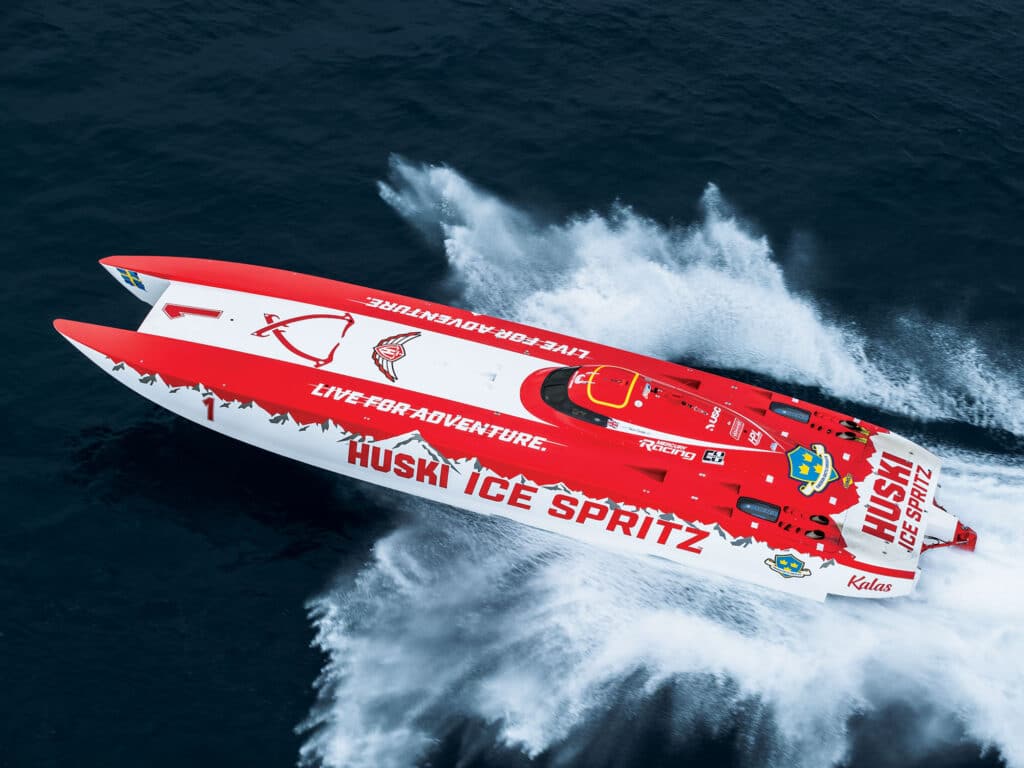
In this age of 70 mph pontoons , 90 mph center-consoles and 150 mph sport cats, it’s pretty easy to experience eye-popping velocity on the water. So, there you are, the wind flapping your cheeks as you hold that throttle to the stop, one watering eye on the speedo as you bump the trim hoping to squeeze out the last bit of speed it will take to be the first boat to the poker-run card pickup. Maybe you even imagine that’s Reggie Fountain , Steve Curtis or Shaun Torrente at the helm of the boat you are pursuing, and instead of a king of hearts, there’s a big trophy waiting at the finish line. Well, dream on, Speed Racer. You’re going fast, but you are not racing, and your production-built motorboat is no race boat.
Steve Curtis throttles a real race boat. The Victory catamaran Huski Chocolate carried Curtis and drivers Travis Pastrana and Brit Lilly to the 2022 UIM Class 1 championship in the Powerboat P1 Offshore series. Last summer, we met Curtis and this boat, now rechristened Huski Ice Spritz, at the Mercury Racing Midwest Challenge in Sheboygan, Wisconsin, the fourth event on the five-race 2023 P1 schedule. The boat is owned by SVEA Racing Inc., based in Stuart, Florida, regarded as the benchmark in professionalism and experience in Class 1 and led by technical director Gary Stray, director of operations Scott Colton and crew chief Patrick Cleaveland.
Curtis, a 59-year-old Englishman and the son of Cougar Powerboats founder and racing catamaran innovator Clive Curtis, claimed his first Class 1 world championship in 1985 in Key West when he was 21 years old. In his career, Curtis has throttled more than 20 world champions. Who would be better to show us under the cowl of a Class 1 race boat than the acknowledged master of throttling racing cats?
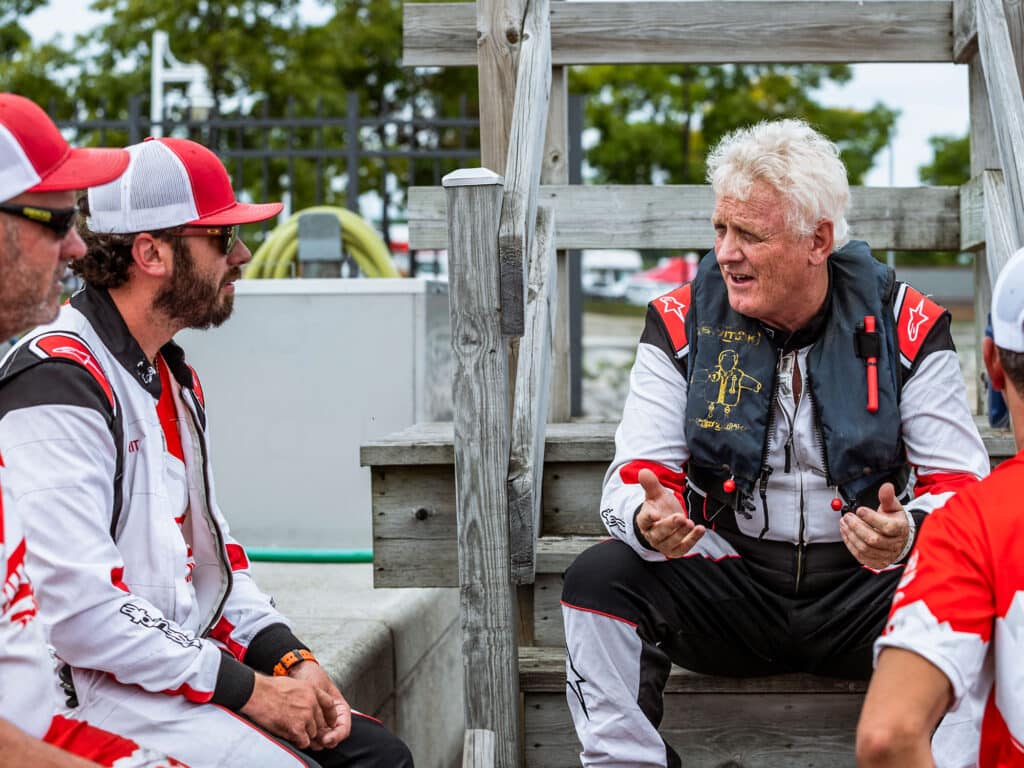
Class 1 is the premier category of international offshore powerboat racing. A P1 Offshore event can include a number of classes, but only the Class 1 Championship is sanctioned by the UIM (Union Internationale Motonautique), the world governing body for all powerboating activities. Basic rules for Class 1 dictate a minimum boat length overall of 12 meters (about 39 feet) and a minimum weight of 5,400 kilograms (just over 11,900 pounds). There have been seven boats in the Class 1 field in 2023, ranging in length from the 43-foot Skater Monster Energy/MCON to the 51-foot Mystic dfYoung. The Huski Ice Spritz/SVEA Victory is 47 feet length overall, with a running surface of 41.5 feet, according to Curtis, and a 12-foot beam. Curtis explains that the bigger boats often have an advantage in rough conditions, but the smaller boats can be nimbler in a current on flatter water in a tight, multiturn closed course—the 5-mile course at Sheboygan had 10 turns.
“Courses have become smaller to make the event more spectator-friendly,” Curtis says. “We used to run 40-mile laps and 200-mile races.”
The age of the Class 1 fleet is also surprising. Huski Ice Spritz/SVEA was built in 2007 by the Victory team in Dubai to a Michael Peters design.
“The boat has been rebuilt and repowered a number of times,” Curtis says. “I believe it was originally powered by Lamborghini V-12 engines. The boat has been crashed and repaired. The entire deck has been replaced, and the running surface adjusted as the engine package has changed.”
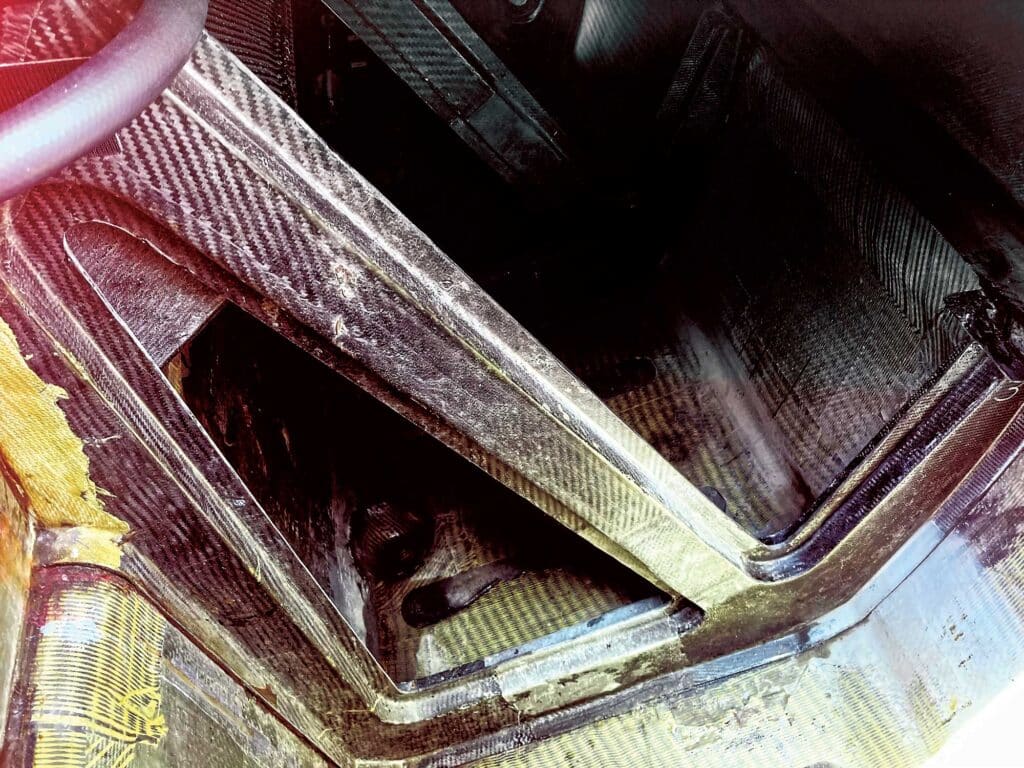
Carbon, Of Course
The overall theme of a race boat is that every element is functional, and this is the key difference between Huski Ice Spritz and your go-fast rig. Speed and safety are all that matter. The hull and deck are laid up with a combination of carbon fiber and Kevlar composite, with foam coring of various density. Bulkheads are carbon fiber, molded in a combination of triangulation and U-channel shape, and bonded within the hull. Each sponson has a pair of steps that are about 1.5 inches deep and a single strake. The tunnel between the sponsons is designed to trap and compress air, which lifts the boat at speed. The tunnel is about 33 inches deep at the bow but only 22 inches deep at the transom.
A V-hull boat could run in Class 1, but the catamaran offers a significant advantage, according to Randy Scism, who helped establish the Victory team as a force in offshore racing before returning to the United States in 1998 to start performance boatbuilder Marine Technologies Inc.
“A comparable V-hull boat will be 20 to 30 mph slower at top speed,” says Scism, who designed the 48-foot MTI Class 1 cat XInsurance/Good Boy Vodka. “In some conditions, it might corner better, but it could never make up the difference in total lap time. The air cushion under a cat can carry 30 to 35 percent of the boat’s weight, so the bottom is not even touching small waves and chop.”
Builders seek to produce a boat that is significantly below the class minimum-weight specification. This allows each team to make weight using lead ballast—water ballast is not allowed—that can be positioned right on the stringers to keep the center of gravity as low as possible to enhance handling and help trim the boat. Weight, either lead bars or bags of lead shot, can be placed aft to lift the bow in calm conditions or forward to hold the bow down in rough water. Fuel tanks are located directly on the boat’s center of balance so that balance does not change as fuel is consumed. At race venues, a crane fitted with a scale lifts the Class 1 boats from the trailer to the water; this way, each boat is weighed every time it goes in and comes out of the water to prevent cheating.
At Class 1 speeds, aerodynamics becomes critical. The boats literally fly over the water, and the deck is flush with the top of each sponson. The enclosed cockpit is a teardrop blister, hatch latches and cleats are carefully recessed and faired, and air intake is accomplished with low-drag NACA ducts. When conditions are ideal, these huge boats appear to levitate with a grace that belies the brutal thrust required to reach speeds that can exceed 160 mph on the open ocean.
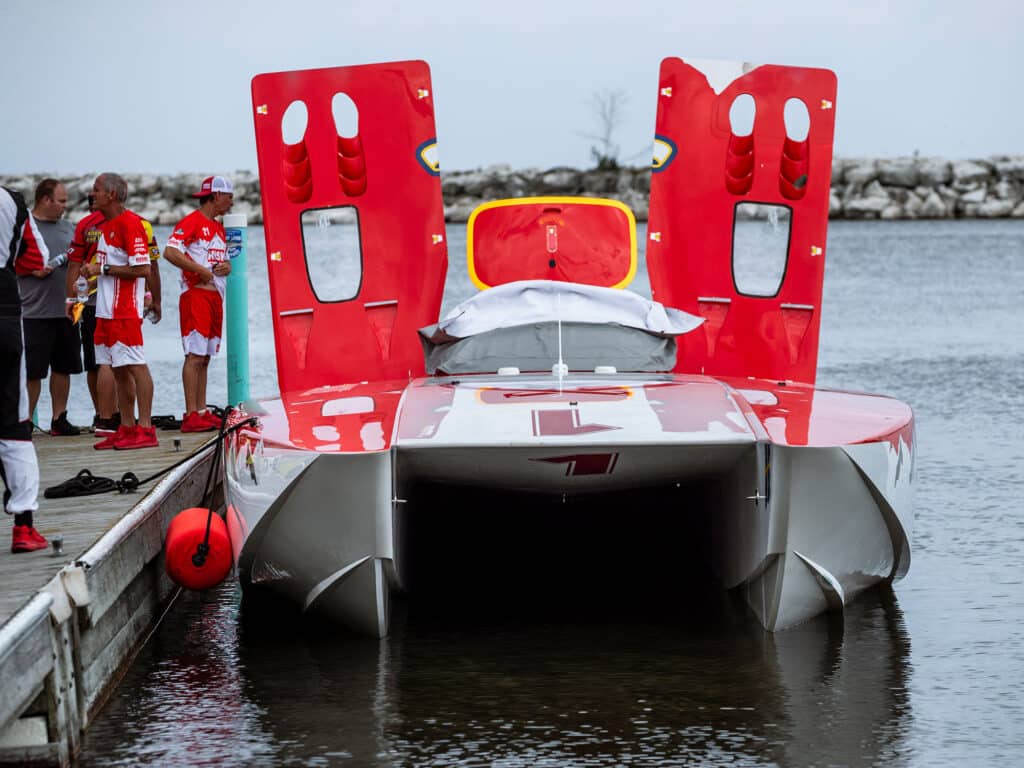
Prescribed Power
There are no surprises below the engine hatches of a Class 1 boat. Since P1 led a revival of the class in 2019, the Mercury Racing 1100 Competition engine has been standard power, a spec engine for the class. The 9.0-liter V-8 engine features Mercury Racing QC4 quad-valve cylinder heads and is boosted by twin turbochargers. Power output is 1,100 hp and 1,100 lb.-ft. of torque per engine on 93-octane pump gasoline. Each big V-8 turns 6,000 to 6,500 rpm. The transmission is the stout model designed for the Mercury Racing 1750 engine with a stronger input shaft and internal components.
“Before the switch to the Merc 1100, we were running engines making 1,850 to 2,000 hp at 7,500 rpm,” Curtis says, “and top speeds pushed 190 mph. Those engines needed a rebuild after each race.”
The point of a specified engine for the class is to reduce cost and ensure power parity among teams with unequal resources. With that in mind, the engines are tightly controlled. Teams are not allowed to make any adjustments or modifications to the engines. With the exception of the valve covers, the engines are sealed with special fasteners. At the beginning of each race weekend, the Mercury Racing support team delivers propulsion control modules (PCM) to each team. The PCM units are painted bright yellow so they are easy to identify. Mercury Racing also installs a data logger on each engine.
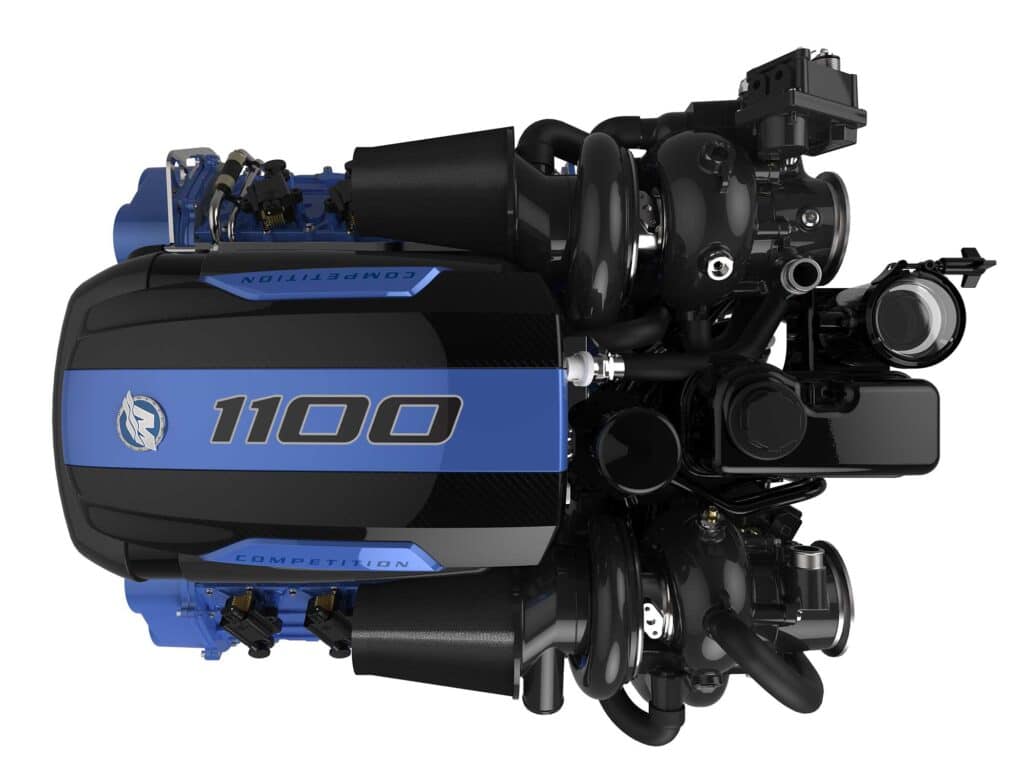
“After every practice and every race, we download the data to make sure it makes sense and that nobody has tweaked on the engines and turned the power up,” says Steve Wynveen, Mercury Racing manager of development engineering. “The idea of Class 1 now is that winning is dependent on driving and boat setup, not on who has the most money to throw at an engine.”
The expectation is that if teams don’t abuse these engines by constantly banging into the rev limiter, each can last the season with just basic maintenance. Teams will put between two and three hours of run time on the engines at each race weekend. Teams are free to install their own PCM for testing between races.
The Huski Ice Spritz/SVEA team engineered a number of quick-disconnect fittings that allow it to remove an engine in about 20 minutes, according to Curtis. This team pulls its engines after each race for maintenance and inspects the bilge and engine mounts below the engines. Typical maintenance includes an oil and filter change, checking the valve lash and adjusting with shims, a compression and leak-down test, checking the turbocharger waste-gate adjustment, and torquing all fasteners and clamps.
Six of the boats in this Class 1 fleet use surface drives based on a BPM model to put power to the water. The Italian drive only articulates in the vertical plane, which provides a limited range of trim, generally less than 15 degrees or, according to Curtis, about 1.5 inches at the propeller. The prop is located about 58 inches abaft the transom. A drop box located on the exterior of the transom allows teams to quickly change gear ratios to best match engine torque to the prevailing conditions. Curtis explains that on today’s short courses, acceleration out of turns is often more important than top speed. Teams using a surface drive are limited to three prop sets but have unlimited gear ratios. Steering is accomplished by a center-mounted rudder—a knife-sharp polished stainless Italian Flexitab model on Huski Ice Spritz—and teams can change rudders based on water conditions.
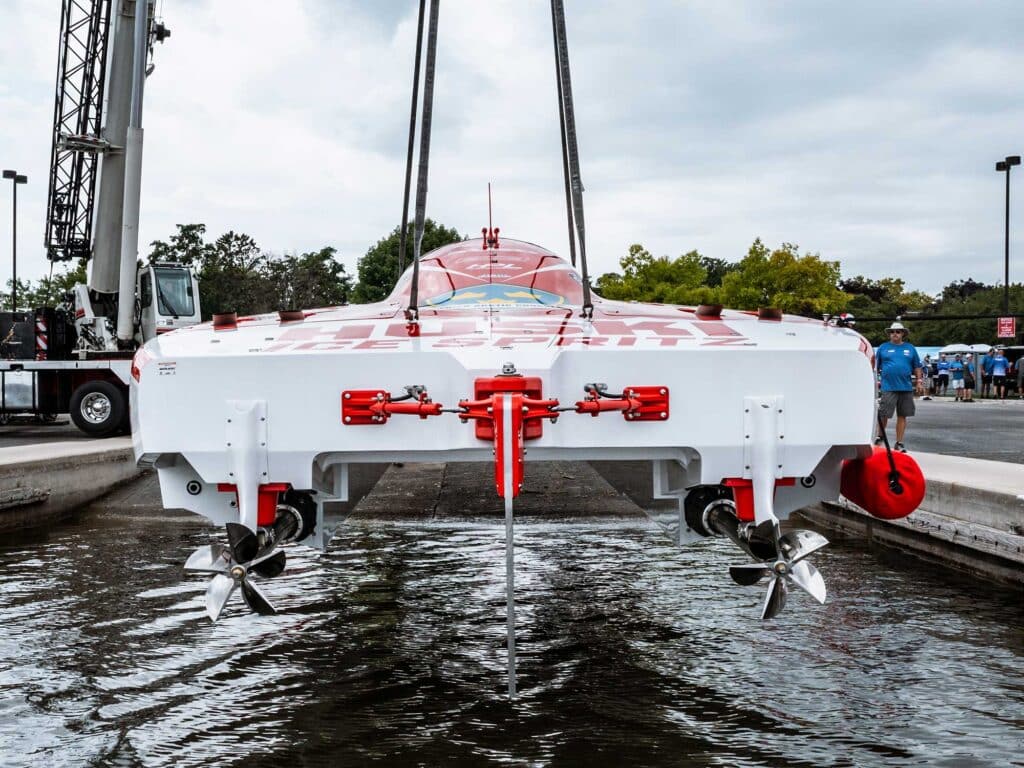
A sterndrive is also permitted in Class 1, but if the sterndrive can steer, the boat is not allowed to use a rudder. The MTI XInsurance/Good Boy Vodka boat is rigged with modified Mercury Racing M6 sterndrives. Trim is retained, but the skegs are cut off and steering is locked. The boat is equipped with a rudder. Teams running sterndrives are allowed an unlimited number of propellers.
“The problem with trying to steer these boats with the sterndrives is that when you turn the drive, one prop is pushed into water and the other into the air coming through the tunnel,” Scism says. “The prop in the air loses thrust. You want to keep both props centered behind the sponsons. I prefer to use the M6 drives for the added trim authority. That drive is plenty rugged for these engines.”
Read Next: How to Boat Safely at Any Speed
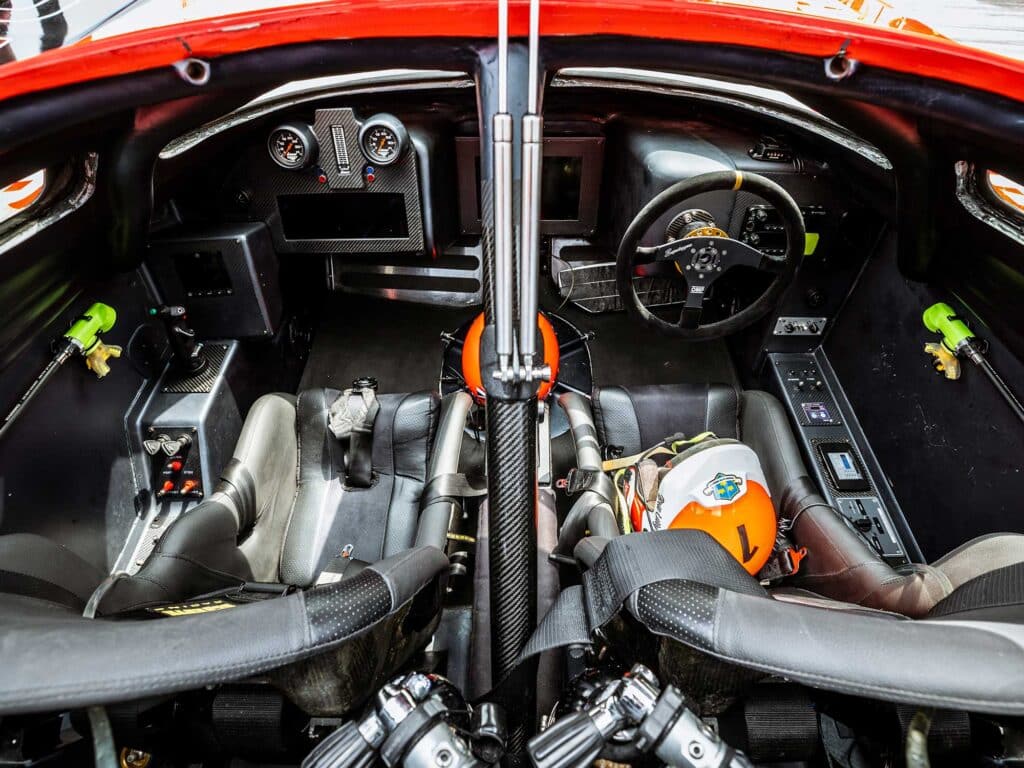
Curtis throttles with his right hand gripping a pair of Mercury Zero Effort controls topped with red plastic knobs molded to the shape of his hand. To his left is a fixed, molded grip with radio/intercom control buttons, trim control, and a button to change the screen display. Curtis can communicate with his team using VHF and UHF radios, and a cellular connection. Below is a pair of Mercury ignition keys, which we were surprised to see.
“When we went to the standard Merc 1100 engines, we wanted to retain the entire stock wiring harness to prevent any sort of tampering,” Curtis says. “So, there are the keys, just like on your fishing boat. It was the easiest solution.”
Facing Curtis are a pair of Livorsi turbocharger boost gauges, a Livorsi trim indicator, and a multifunction display usually showing tachometers. In the center of the dash is a Garmin MFD split between navigation and a rearview camera. The driver sits before a quick-release steering wheel with a lap counter on top of the dash, which will also display a yellow-and-red flag signal from race control.
I wish I could describe the sensation of driving Huski Ice Spritz at speed while looking through the slit of a windscreen. But as it turns out, there is not enough liability coverage or legal cover to ever make that happen. Scism says MTI will build you a new 48 Race model to Class 1 specs, with a price tag of $2.2 million to $2.4 million with power. A $500,000 budget will cover a bare-bones Class 1 team for a season, Curtis says, with a well-financed team spending more than $1.5 million. SVEA Racing Inc. brings a crew of 10 to each race with a 70-foot race trailer, a tilting boat trailer and its Kenworth hauler, and a world-champion throttleman. They are not going to a poker run.
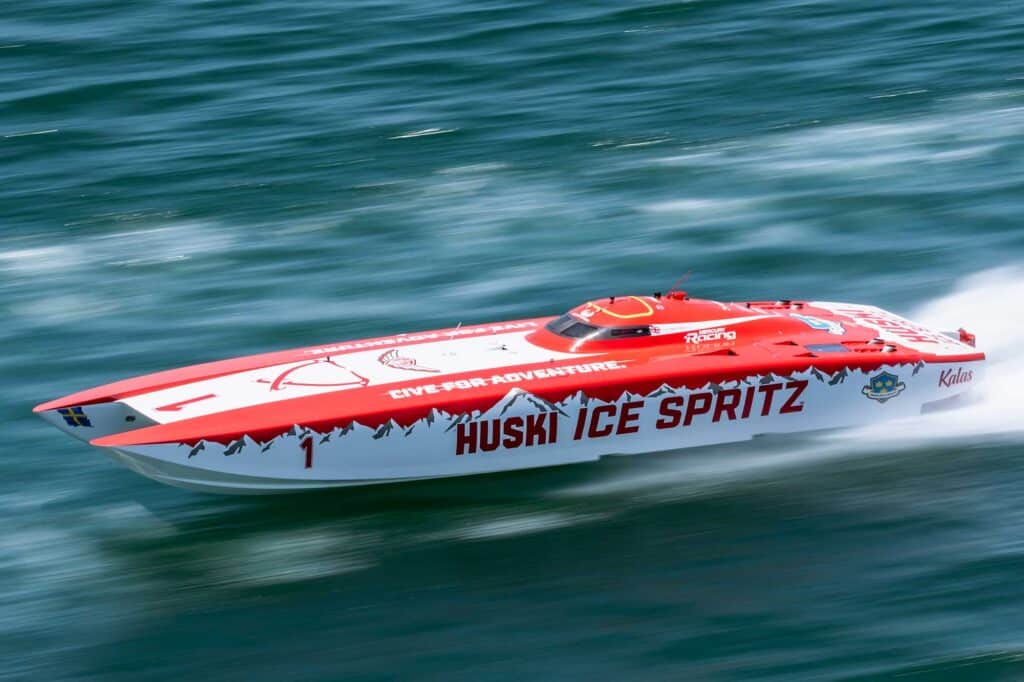
Safety First
When Steve Curtis won his first Class 1 championship, he was standing in an open cockpit. “There was very little concern for safety in those boats,” Curtis says. “If you stuffed the boat, it was very likely you’d be killed.”
Today the driver and throttle work in an enclosed cockpit that is all business. This is not your pleasure boat—there is no Alcantara upholstery, no bass-pumping audio system, and no LED-illuminated drink holders. Cockpit entry is through a hatch secured with four sliding bolts like a bank vault. In Huski Ice Spritz, Curtis throttles from the port seat, and the driver is at the wheel to starboard. Deep bucket seats have 2 inches of suspension travel, and the crew is strapped securely in place. “During a race, it can actually get rather violent in here,” Curtis says. “It’s not very noisy, but there is a lot of vibration, even in smooth water, because the boat is so rigid. We can feel pretty beat up after a race.”
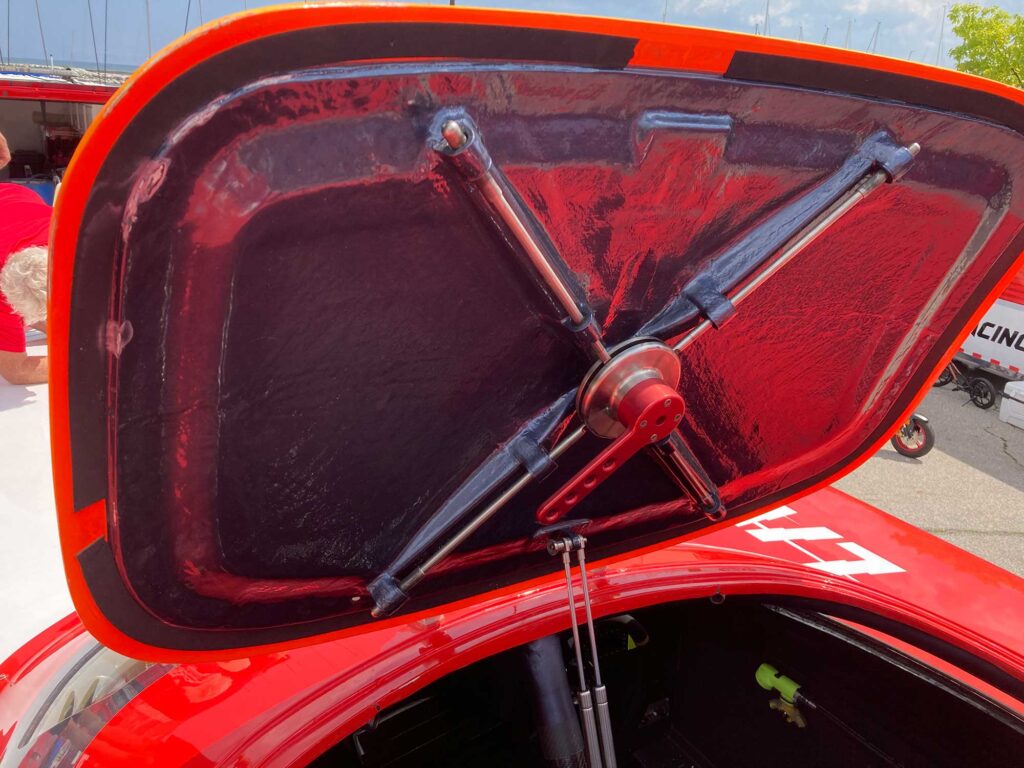
A cage of carbon channels surrounds the cockpit, which Curtis says is backed by a very thick bulkhead. Crush zones around the cockpit are designed to absorb energy on impact. The interior is raw and black, with no thought of cosmetics. The forward portion of the cockpit structure is formed by a ¾-inch-thick polycarbonate shield modeled after a fighter-jet canopy. The clear portion is minimized for further crew protection. There’s an emergency escape hatch in the floor for egress if the boat flips. The driver and throttle have a 10-minute emergency air supply.
- More: Performance Boats
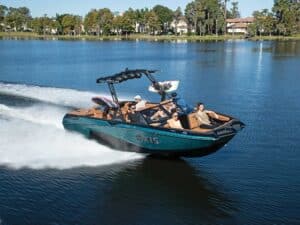
Boat Test: 2024 Axis A245

2024 Viaggio Lago V 16U
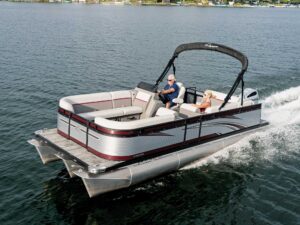
2024 Qwest E-Class Lanai LTZ
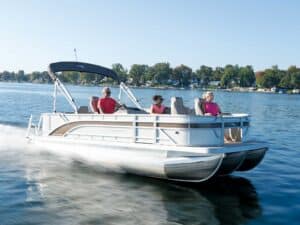
2024 Bennington 20 SF-SPS
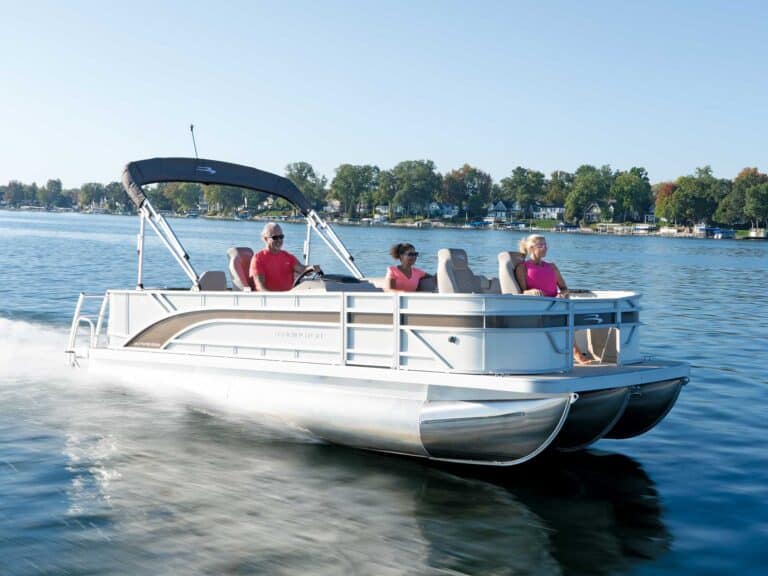
2024 Bennington 22 SVSB-SPS
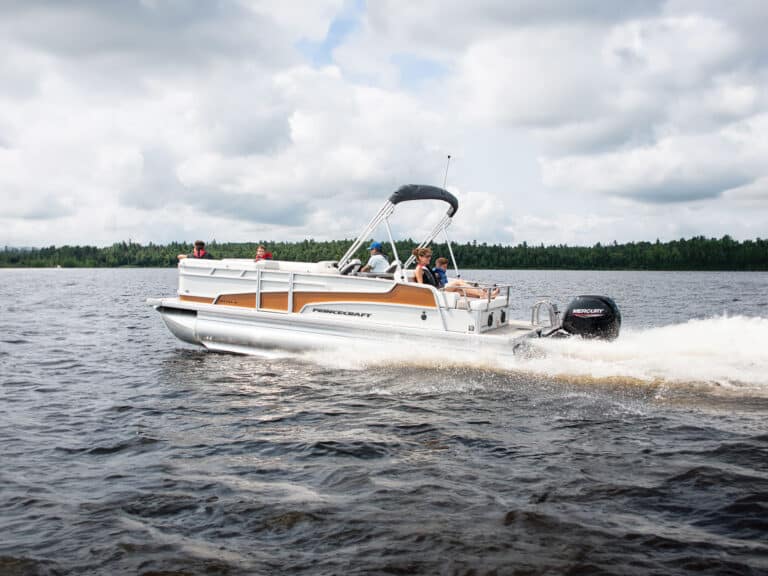
2024 Princecraft Vectra 23 RL
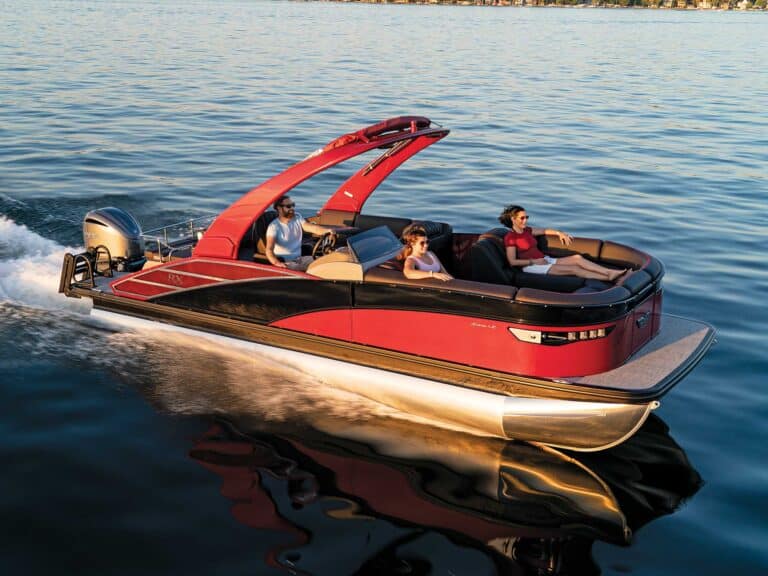
2024 Bennington 23 RX Sport Swingback

- Digital Edition
- Customer Service
- Privacy Policy
- Cruising World
- Sailing World
- Salt Water Sportsman
- Sport Fishing
- Wakeboarding
Many products featured on this site were editorially chosen. Boating may receive financial compensation for products purchased through this site.
Copyright © 2024 Boating Firecrown . All rights reserved. Reproduction in whole or in part without permission is prohibited.
- In the News
- Speed On The Water Videos
- Racing Reports
- Countdown To The 2024 Miami International Boat Show
- Coverage Of The 2023 Lake Of The Ozarks Shootout
- Coverage From The 2023 Key West Poker Run And Offshore World Championships
- Image of the Week
- Safe Boating
- New Products
- Featured Boat
- Latest Projects
- Year in Review Print Magazine
- Subscriber Login/Logout
- Subscribe to SOTW Magazine
- Buy Single Digital Mag Issues
- Magazine Archives
- Magazine Features
- Events Calendar
- Advertising Information
- Article Plaques
- Industry Partners

Sarasota Powerboat Grand Prix Day One: Super Stock And Bracket Class Winners
The oldest saying in offshore powerboat racing is “to finish first, first you have to finish,” and that couldn’t have proven truer as the favorites in Super Stock and Bracket 500 succumbed well before the checkered flag waved on the first day of action at the 39th annual Sarasota Powerboat Grand Prix in Sarasota, Fla. Produced by Powerboat P1 , the Grand Prix is the third race of the American Power Boat Association Offshore National Championship Series and the second race of the Union Internationale Motonautique Class 1 World Championship Series.

The Super Stock fleet at the Sarasota Powerboat Grand Prix included 11 catamarans. Photos by Pete Boden/ Shoot 2 Thrill Pix
In Saturday’s final race, the 11 boats in the Super Stock class took to the Gulf of Mexico. Winds were picking up and there were white caps, but conditions were fast and racy. As they did in the first two races of the season, the 32-foot Victory catamaran, Jackhammer , with owner/driver Reese Langheim and throttleman Julian Maldonado bolted to the lead. Giving chase was a pack of boats including the 32-foot MTI cat, CMR, with driver/owner Sean Conner and John Tomlinson subbing for Shaun Torrente on throttles. Throttleman Rusty Williams and driver Myrick Coil in the 32-foot Doug Wright, Performance Boat Center /FASS Diesel Fuel Systems, were in the mix as were owner/driver Daren Kittredge and throttleman Grant Bruggemann in the 32-foot Doug Wright, Northwing Offshore.
A total of 64 teams descended on the city on the west coast of Florida that has become one of the favorite sites in offshore powerboat racing. A checkered flag from Sarasota is rivaled only by one from the world championships in Key West, Fla., in November. The weekend kicked off with a party on Friday evening where fans could meet the teams at the 10th Street ramp party followed by racing in the bracket 500, 600 and 700 classes and Super Stock boats, plus Class 1 pole position qualifying on Saturday.
The day started with calm conditions, but winds slowly built through the day and temperatures in the mid-90s added to the challenge.
It didn’t take long for the teams in the ultra-competitive Super Stock class to push the limits. The 32-foot Doug Wright, LPC, with owner/throttleman Loren Peters and driver Anthony Smith, started moving up through the fleet when it rolled on the outboard leg of the 6-mile course that had the racers navigating in a clockwise direction. Competition was halted after less than a lap. Peters and Smith were OK and the boat was hauled back to the pits.

The CMR team of Sean Conner and John Tomlinson ran a consistent race to earn the Super Stock-class checkered flag.
The carnage took its toll quickly. In that first lap, the 32-foot Doug Wright, Team Allen Lawn Care and Landscaping, appeared to have something torn off the stern and didn’t make the restart. Neither did the 32-foot Doug Wright, Team Bermuda.
After many Super Stock competitors voiced concerns about quick green flags in Cocoa Beach at the previous P1 Offshore race, the starters made sure the boats were grouped more fairly in Sarasota. When the green flag flew on the restart, Jackhammer jumped to the lead, with CMR, Performance Boat Center and the 32-foot Victory, Big East Construction, which is owned and driven by Cole Leibel and throttled by veteran Gary Ballough, giving chase in a tight pack.
It didn’t take long for attrition to rear its ugly head. Jackhammer had an engine go into guardian mode, which shuts down the 300-hp outboard to prevent more significant damage. “Nothing like stopping and going every 30 seconds,” Maldonado said. “We had a 14-second lead at the start and guardian started and never stopped.”
The team kept the boat on the same lap as the leaders and appeared to just be running for points.
CMR and Performance Boat Center battled for the lead, with each boat enjoying an advantage on different parts of the course.
“In head seas, they’d catch me, and in following seas, I’d catch them, and it went like that for a few laps,” said Tomlinson, who had raced with Coil in the Super Cat class previously and knew that he could enter a turn with his competitor/friend and not worry about any incidents or collisions.

Check out the slideshow above for more images from the Super Stock race.
Unfortunately, the battle to the finish didn’t materialize when Performance Boat Center pulled off with mechanical issues. Big East Construction moved into second and appeared to be in position for a much-needed podium finish until broken motor mounts forced Ballough to shut down one engine and limp around the course attempting to gain as many points as possible.
With CMR in the lead, Torrente, who qualified for the pole position at an F1H2O tunnel boat race on Saturday afternoon in France, watched on his cell phone while eating dinner with his family. Tomlinson and Conner took the checkered flag followed by Pete and A.J. Bogino in the 32-foot Doug Wright, CoCo’s Monkey, and Jackhammer, which kept running because the race isn’t over until the checkered flag waves.
“I’m pacing the streets of France as we walk back from dinner,” Torrente said in a message to speedonthewater.com from overseas. “It was an amazing race. Sean was turning the boat incredibly and Johnny was getting used to the boat and kept getting quicker and quicker. I’m so thankful for him sitting in for me.”
But as we always report on speedonthewater.com, all results are unofficial pending official inspections and video reviews. According to the APBA Offshore Commission chairman Rich Luhrs, four combined lane infractions at the start and post-accident restart that resulted in four yellow cards (Luhrs declined to name the penalized teams.) That, in turn, changed the official finishing order. Though CMR retained the checkered flag, Jackhammer moved into second place, followed by Big East Construction in thrid.
Almost serving as a harbinger of what was to come, the Class 1 boats took to the 6-mile course to see who would claim the coveted inside lane on Sunday afternoon. The boats ran a “get-comfortable-with-the-course” lap and then followed that with two timed laps. The fastest time would give a team the pole position on Sunday. First up was the team of throttleman Steve Curtis and driver Brit Lilly in the 47-foot Victory cat, Huski Ice Spritz.
In the end, owner/driver Darren Nicholson and throttleman Giovanni Carpitella in their own 47-foot Victory, 222 Offshore Australia , posted the fast number of the day—3:05:85. Tomlinson, who is pulling triple-duty this weekend, joined driver Travis Pastrana and clocked the third fastest time of the day in their 50-foot Victory, Pothole Heroes. The other three Class 1 entries had mechanical issues and didn’t complete a lap.

In the Bracket 500 class, throttleman Elijah Kingery and driver Eric Ullom ran a great race in their 29-foot Warlock, Bulletproof/Team Farnsworth.
Whetting Fans’ Appetites The offshore racing action kicked off at 1 p.m. when the Bracket 500, 600 and 700 classes took to the course. Bracket racing takes a different approach because each class has a set speed limit. If a team exceeds the speed limit, it “breaks out” and is penalized for doing so.
The Bracket 500 fleet had nine teams including two 30-foot Phantoms that racing fans would consider to be favorites. Owner/driver J.J. Turk and throttleman Micheal Stancombe were the defending national champions in TFR/XINSURANCE and when the race started, they had a strong challenge from throttleman Elijah Kingery and driver Eric Ullom in the 29-foot Warlock, Bulletproof/Team Farnsworth, and the father-son team of Rob and Vincent Winoski in their 30-foot Phantom, Bronx Phantom.
Bracket racing is about more than just making sure you don’t exceed your class’ listed speed. It’s about letting your competitors drive away from you when they are going faster in the heat of competition and run the risk of doing just that. That story didn’t pan out because TFR/XINSURANCE pulled off the course with a mechanical problem first, followed by Bronx Phantom.
“We kind of knew that Bronx Phantom broke out because we were at 74.9 mph and they pulled away from us so we backed down a bit to make sure we didn’t break,” Kingery said. “We let them go and then when we saw J.J. break, half a lap later, we could hear Bronx Phantom’s motor starting to break up.”

Enjoy more pictures from the Bracket-class competition in the slideshow above.
This may have resulted in a historical finish with two 29-foot Warlocks finishing first and second in an offshore powerboat race. Hammerheads/Fly SRQ with driver Dennis Austin and throttleman Don Jackson took second followed by YabbaDabbaDo with driver Larry James and throttleman J.D. Ivines in third.
The second start of the day featured a deck-to-deck battle in Bracket 600 between a couple of 26-foot Joker V-bottoms for all five laps on the 6-mile course. George Ivey drove his new boat while Damon Marotta throttled Ivey Racing against a pair of 22-year-olds who have a big future in the sport, throttleman Ryan Stahlman and driver Reef Delanos in Freebird.
The two boats appeared to have a rope connecting their admiships cleats at the start. One took the lead and then the other but in the end Freebird continued its momentum after winning in Cocoa Beach.
“I’m definitely hooked,” said Stahlman, who started navigating in his father’s 41-foot Apache, Predator , last year. When asked what he learned from his race in Sarasota, the youngster said, “How to take corners when you have someone with you like that. You have to hold your lane.”
Finally, in the Bracket 700 class, Brian Guy, owner of the 21-foot Superboat, Jackhammer , gave a performance boat enthusiast the opportunity to check an item off his bucket list.
Instead of racing with his usual throttleman, Julian Maldonado, Guy ran with throttleman Francisco Duran, from San Juan, Puerto Rico, who is close with the Maldonado family.

Jackhammer owner and driver Brian Guy won the Bracket 700-class race with Puerto Rican Francisco Duran, who was racing in the United States for the first time, on the throttle.
“He never raced a boat in the states and he always wanted to do this,” Guy said.
Guy added that he broke a couple blades off his prop on the first lap but could still run about 56 to 57 mph in the class bracketed at a top speed of 60. The battle was behind him as a pair of 22-foot Velocitys powered by single Mercury Racing 300Rs fought for position. In the end, Dees Nuts/Meara Classic Cars took second followed by Statement Marine .
As if letting Duran check an item off his bucket list wasn’t enough, Guy’s five-year-old daughter, Kora, also was on hand to see dad win.
“She helps out and is a big supporter of mine,” Guy said.
That’s something attrition can never take away.

Spectators lined the beach in Sarasota to catch the racing action.
Related stories : 2023 Sarasota Powerboat Grand Prix The Super Cat Family Takes Care Of The Brothers Muller Gallery Of The Week: XINSURANCE/Good Boy Vodka Nails First Test Session In Sarasota Florida Sponsors Providing Backbone For Powerboat P1 In Sarasota And Beyond Triple Duty: Tomlinson Adds Throttleman For Super Stock CMR Team To Sarasota Race Responsibilities The Sarasota Powerboat Grand Prix Looms—And The Class 1 Plot Thickens Mod V Class Points Chase Tight Heading Into Sarasota Super Cat Team Spotlight: SV Offshore Racing’s Diorio Calls ‘Podium’ For Sarasota Super Stock Team Savage Set For Sarasota Debut Super Stock Team Spotlight: Northwing Ready To Defend Home-Water In Sarasota Powerboat P1 To Celebrate Race No. 700 In Sarasota The Sarasota Powerboat Grand Prix Looms—And The Class 1 Plot Thickens Pastrana And Tomlinson To Share Class 1 Pothole Heroes Cockpit In Sarasota Sarasota Powerboat Grand Prix Day No. 1 Essentials: Schedules, Storylines And More
2023 Offshore Powerboat Racing Coverage Man Of His Word: Valder Claims LOTO Powerfest Super Cat Victory Cocoa Beach Wrap Up: The Last Lap Is The One That Matters Living Up To Their Name In Cocoa Beach 7 Mile Offshore Grand Prix Wrap Up: Wild Weather, Eight Laps And Five Crashes
Torrente Snags Last-Gasp Pole Position For Tomorrow’s Grand...
Sarasota powerboat grand prix essentials day no. 2: schedule....

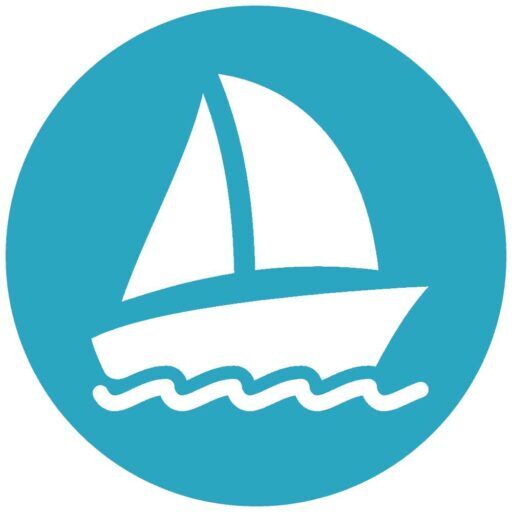
WaterCraft 101
Your guide to fun on the water!

17 Things You Didn’t Know About Powerboat Racing (Revealed!)
Powerboat racing is a sport with thrill, adventure, and a little danger. But apart from the enticing characteristics of this water sport, there are facts about powerboat racing that many boat enthusiasts seem not to know. For instance, did you know that the windows used for powerboats came from F-16 fighter jets?
If you are curious about powerboat racing and the facts behind them, let me share 17 things that you probably don’t know about this sport.
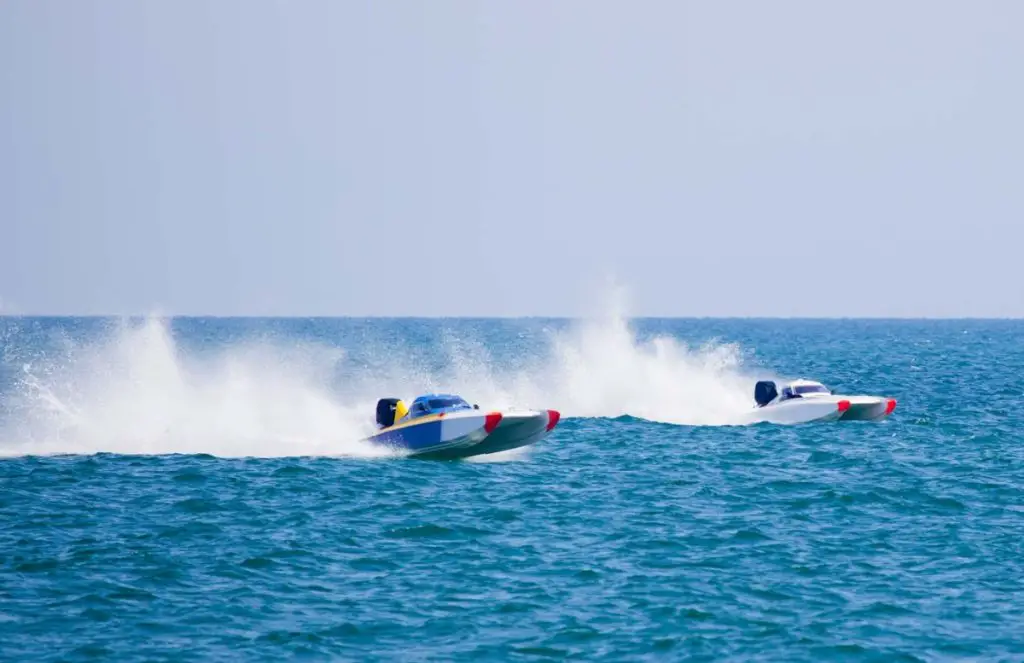
17 Facts About Powerboat Racing That You Need To Know
Powerboating is an extreme sport that first began over 100 years ago. The powerboats that today’s drivers use have high-performance engines that allow them to run at extremely high speeds.
Powerboat racing is a worldwide sport and has numerous international events every year, making it one of the most popular water sports there is.
But this fact is not the only thing you need to know about powerboat racing. Here are 17 more facts about this exciting sport that you probably didn’t know.
Fact #1: Powerboat Racing Came To Be Because Of Two Men Named Charles
Charles Merivale, a Cambridge student, challenged Charles Wordsworth, an Oxford student, to a river race in 1829 . The race involved eight rowing crews and took place in Henly-on-Thames.
Wordsworth won the race, and after 27 years , the race became an annual event. While the first races were rowing races, they eventually led to powerboat racing as boats with engines came on the scene.
Fact #2: The First Major Powerboating Race Happened In 1903
The American Power Boat Association (APBA) is a membership-owned corporation. It is the sanctioning authority in the US for the Union Internationale Motonautique – the world’s powerboat racing governing body.
Moreover, the APBA organized the Gold Cup, the first major powerboating race , in 1903. ( source )
Fact #3: A Formula 1 Powerboat Has A Crash Box
A powerboat race is a serious sport that poses extreme risks to the participants. These risks include collision or crashing. For this reason, a Formula 1 powerboat’s cockpit has an enclosed capsule construction. It detaches from the rest of the boat during an accident to keep the boater safe.
The crash box also has other safety features. That includes:
- waterproof and damage-resistant crash box
- safety belt
When an accident happens, the crash box records the boat’s internal operations, allowing the governing authority to easily make a post-crash analysis. ( source )
Fact # 4: The Crash Box On Powerboats Only Became Mandatory In 2007
While powerboat racing is an extremely dangerous sport, organizers only required powerboats to have a crash box during the 2007 season. The high fatality rate in powerboating competitions prompted the organizers of such events to pay more attention to the safety of the participants.
As a result, powerboats now have safety features such as crash boxes, shock-absorbent designs, and airbags. ( source )
Fact #5: A Wooden Boat Holds The World Record For The Fastest Water Vehicle
The Spirit of Australia is a wooden boat constructed by Ken Warby in 1972. Warby did not have enough budget for high-quality boat parts, so he purchased timber and plywood that he could use for his project.
In addition, Warby only used three power tools to complete his boat:
- circular saw
- belt sander
To power the Spirit of Australia, he purchased three J-34 engines. Two of the engines cost $100 each, while he bought the third one for $60.
Warby set his boat’s official world record on October 8, 1978, at New South Wales, Australia’s Blowering Dam Lake. He drove his boat at 317.58 mph, allowing him to set the world water world record using a backyard-built boat. ( source )
Fact #6: The Longer The Boat, The Faster The Speed
William Froude first noticed the relationship between a boat’s length and speed. He did his observation in the 1800s while he was researching warships for the British Admiralty.
Froude discovered that a boat that is longer than its waterline has the slightest drag. Such results in a faster speed.
Moreover, William I. Koch Marine Technology Professor Jerry Milgram backed Froude’s observation. According to the professor, the balancing act between a boat’s power and length affects how fast it can go.
Even now, the “Froude numbers” are essential for designing speedboats. The speedboats used for powerboat racing have long and sleek shapes. ( source )
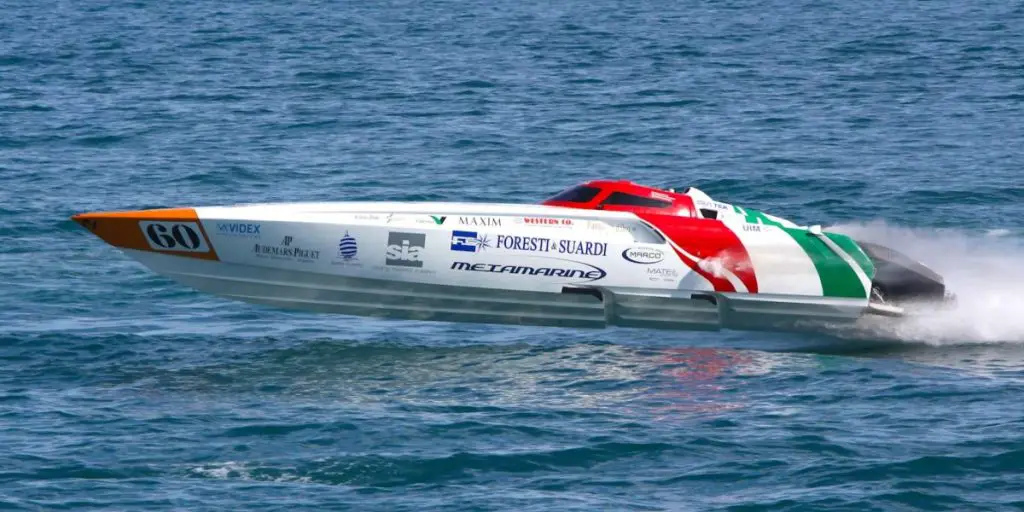
Fact #7: Powerboats Do Not Have Gears
The gearbox in powerboats does not have gears inside them. Instead, this gearbox is used to engage and disengage the propeller and engine. Boats do not need gears since they operate in the water and not on land.
Driving on the water is a lot different from driving on land. The harder a boat pushes into the water, the more the water resists. So, if a powerboat pushes the water hard, it will create friction , causing the boat to slow. That said, boats always need to be in low gear to maintain speed.
More than that, adding gears to a powerboat will cause unnecessary complexity. Such will result in undesired issues, such as increased fuel consumption and drag. So, in the end, adding gears to a powerboat would be counterproductive. ( source )
Fact #8: Racing Boats Have Systems To Let Drivers Breathe Even When The Cockpit Is Full Of Water
It is not only the cockpit that makes powerboat racers safe if a crash happens. The racers also equip themselves with multiple protection systems . They need to wear a certified helmet and a head restraint called a Head and Neck Support device (HANS).
In the instance where a powerboat crashes, HANS prevents the driver from acquiring head and neck injuries.
The people who participate in powerboat racing also wear a mask connected to an oxygen supply on board. This system allows the boaters to breathe even if water fills the cockpit. ( source )
Fact #9: Powerboat Materials Were Once Timber Wood And Plywood
The initial design of powerboats consisted of either plywood or timber wood. The problem is that these materials cannot withstand the force coming from a high rate of speed. The speed of the wooden boat and the fragility of the materials used to make it caused accidents during powerboat racing.
In the early years, speedboats didn’t have enclosed cell cockpits and safety harnesses yet, making this sport even more dangerous. For this reason, British powerboat designer Chris Hodges wanted to increase the safety level of powerboats, giving life to boats with enclosed cockpits.
In his design, he did not attach the cockpit to the boat’s main structure. Instead, it connects to the central area and hull of the boat. This design allows the hull to absorb impact in case of an accident, protecting the driver and reducing any injury they may suffer. ( source )
Fact #10: Racing Powerboats Are Fast Enough To Make F1 Race Cars Look Slow
A Formula 1 powerboat has supreme speed with a very fast acceleration, making the F1 powerboat unrivaled in both water and motorsport.
This racing powerboat can even make an F1 race car with a top speed of 160kph look sluggish. Suppose a race car can accelerate smoothly in six seconds. In that case, a powerboat can efficiently run past it within only four seconds.
F1 powerboats reach speeds of up to 225kph. For this reason, not only can a powerboat out-pace a Formula 1 race car during acceleration, it can also leave it in the dust over longer distances. ( source )

Fact #11: Saltwater Can Reduce A Powerboat’s Engine Output
Too much saltwater ingestion through the air intake can affect a powerboat’s engine output during a race. Salt residue can build up on the boat’s turbine blades, which changes the engine’s compression ratio. As a result, the engine’s temperature increases, causing the engine to overheat.
This build-up will create a pre-ignition condition , which will then cause the engine to catch on fire and acquire damage.
Fortunately, a driver can prevent saltwater from reaching their engine by staying ahead of their competitors. This way, the sprays coming from other boats will not get into their engine. ( source )
Fact #12: Powerboat Riders Need To Move The Engine During The Race
The floor and steering wheel of Formula 1 racing powerboats consists of buttons. You can think of these buttons as similar to a car’s driver’s area. The powerboat racing participants use these buttons to bring the outboard engine in and out during a race.
Moving the engine in and out on the boat prevents it from getting in too much contact with the water as it can cause drag. However, too little contact with the water will cause the driver to lose control of the boat. That said, moving the engine’s prop in relation to the water allows the powerboat drivers to have more control over the boat. ( source )
Fact #13: Double Hull Powerboats Have Less Drag
Double hull boats or catamarans are one of the first hull designs ever made. A deck bridges the two hulls , providing the boat with less drag, better stability, and additional beam. As a result, boats with a double hull design are faster than traditional speedboats.
The tunnel created by the two boat hulls allows air to pass through underneath the boat. This reduces the friction between the boat and the water and produces a lifting force that allows for extra speed. ( source )
Fact #14: Powerboats Need To Use The Same Engine
The boats used for powerboat racing all need to use the same engine. A Mercury Marine V6 two-stroke engine powers these boats, thus prompting them to move. This engine can hold 32 gallons of 100LL Avgas at a rate of 129L per hour. Notably, AVgas is a type of fuel used in aircraft engines.
Moreover, the Mercury Marine V6 engine can generate more than 400 horsepower at 10,500 revolutions per minute (rpm). It can also move the boat to 200kph in just two seconds. ( source )
Fact #15: Cigarette Boats Have A Link To Alcohol Distribution During World War I
Cigarette boats are a slender type of boat made out of fiberglass. This design allows cigarette boats to move at extremely fast speeds during a powerboat race.
This type of boat first became popular during the ’20s and ’30s. Cigarette boats even had a controversial history when the US government prohibited the production and distribution of alcohol. Many US citizens used fast cigarette boats to smuggle these goods without the government finding out.
Cigarette boats are also known as “ rum-runners .” These boats were often used to transport illegal alcohol shipments from large ships off the mainland back into the country. ( source )
Fact #16: Water-Jet Propulsion Accelerates A Powerboat More Than A Propeller
Propellers use a set of blades that rotate fast to prompt a powerboat to move on the water. While a water jet has the same concept, the difference is that it uses an impeller located inside a tube. This impeller rotates and accelerates the water out of the tube, resulting in the boat moving forward.
Water-jet propulsion is better than a propeller. All water jets contain and push all the discharge behind instead of outwards as a propeller does. A powerboat’s propeller also needs to work more as it interacts directly with the water.
On the other hand, boaters that use a water jet can move in shallow water. It can even move the boat in many ways. For instance, if a boat used for powerboat racing has two water jets installed side by side, the driver can move forward and sideways. ( source )
Fact #17: The Rules Of The F1 Powerboat Racing Championship Are Similar To That Of F1 Car Racing
The Formula 1 powerboat racing championship rules say that participants need to have 12 teams and 24 powerboats competing against each other. This rule is very similar to Formula 1 car racing championship rules. ( source )
Powerboat Racing – The Takeaway
As sports go, not many are more exciting or dangerous than powerboat racing.
Powerboat racing is an activity with a long-running history. As such, there are many rules and facts in powerboat racing that the average person won’t know. Hopefully, knowing these facts will help you understand and appreciate the sport of powerboat racing better.
- George Gilbert Treherne Treherne, Charles Murray Pitman. The Record of the University Boat Race 1829-1909, and Register of Those who Have Taken Part in it . T. Fisher Unwin, 1909.
- DK. The Sports Book: The Sports, the Rules, the Tactics, the Techniques . China: Penguin, 2011.
- The Player. The Player Bookazine Issue 16 . The Player, 2010.
- Sherry Howard. Boats . Carson-Dellosa Publishing, 2019.
- Bryan Barrass. Ship Design and Performance for Masters and Mates . Great Britain: Elsevier, 2004.
- New Scientist. Why Don’t Penguins’ Feet Freeze?: And 114 Other Questions . Great Britain: Hachette UK, 2016.
- American Academy of Orthopaedic Surgeons. Special Events Medical Services . USA: Jones & Bartlett Publishers, 2010.
- “ Off-Shore Powerboat Racing .” Boating. Vol. 19, Nos. 1-5. January 1996. 31.
- Automotive Industries , Volume 11. Chilton Company, 1904.
- Pacific Motor Boat , Volume 9.
- Sir George Charles Vincent Holmes. Marine Engines and Boilers . Committee of Council on Education, 1889.
- Chris Caswell. “ Double Your Pleasure. MotorBoating. April 2008. Vol. 197, No. 4. 76.
- The Player. The Player Bookazine Issue 20 . The Player, 2012.
- J. Anne Funderburg. Rumrunners: Liquor Smugglers on America’s Coasts . USA: McFarland, 2016.
- Randy Vance. Power Boating For Dummies . USA: John Wiley & Sons, 2009.
Bryan is a Las Vegas resident who loves spending his free time out on the water. Boating on Lake Mohave or Lake Havasu is his favorite way to unwind and escape the hustle and bustle of the city. More about Bryan.
Similar Posts
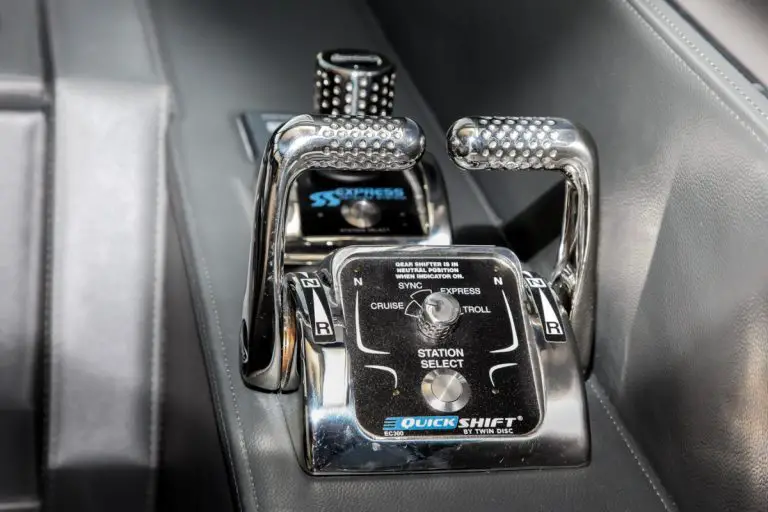
What Is A Shift Interrupt Switch? (And Where To Find It)
The Mercruiser shift system (the most common one) can come across as complicated but it is relatively simple once you get the hang of it. To understand the shift system, you have to start from the basics. So, what is a shift interrupt switch? A shift interrupt switch is a part of the drive that…
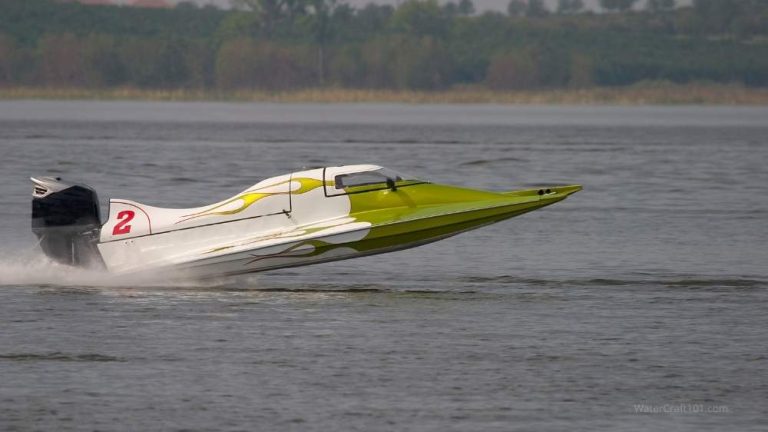
High-Speed Boating (What Is It & How Fast?)
While you may enjoy driving your boat fast as it will go, true high-speed boating takes boating and speed to a whole other level. But what are speed boats, and what is considered high-speed boating? High-speed boating uses a powerboat (a boat with a motor) to travel at speeds between 150 – 200mph or faster….
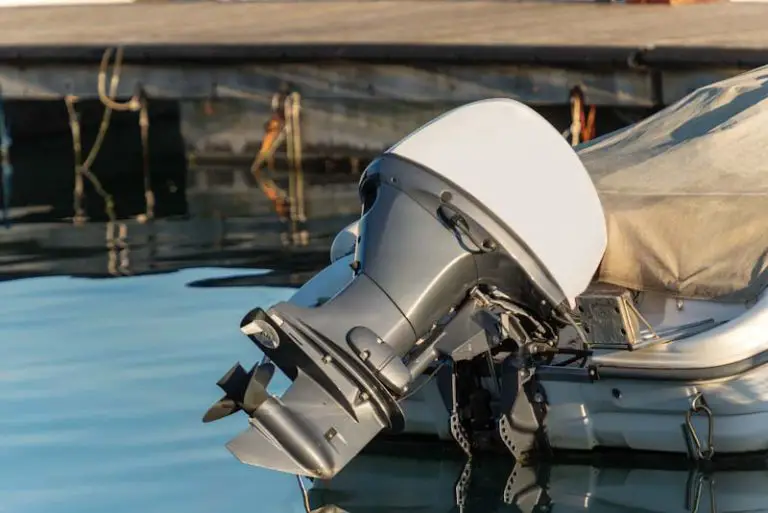
5 Signs Of A Bad Impeller In Outboard Boat Motors (Revealed!)
Despite being a tiny object, an impeller is one of the essential parts of a motorboat engine, and it plays a big part in pumping raw water from outside a motorboat to cool the engine. But it seems as though many motorboat owners do not pay much attention to this part or understand its value….
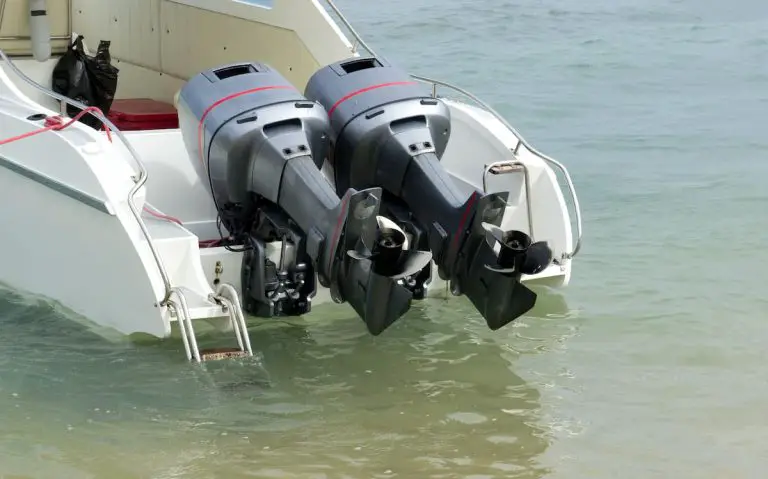
How To Start an Outboard Motor That’s Been Sitting (Fast!)
An unfortunate downside to owning a boat is that sometimes your motor will have to sit for long periods of time without being used. This can result in difficulty starting your outboard motor, but not to worry, there are steps you can take to start your motor just like new. Here are 9 steps you…
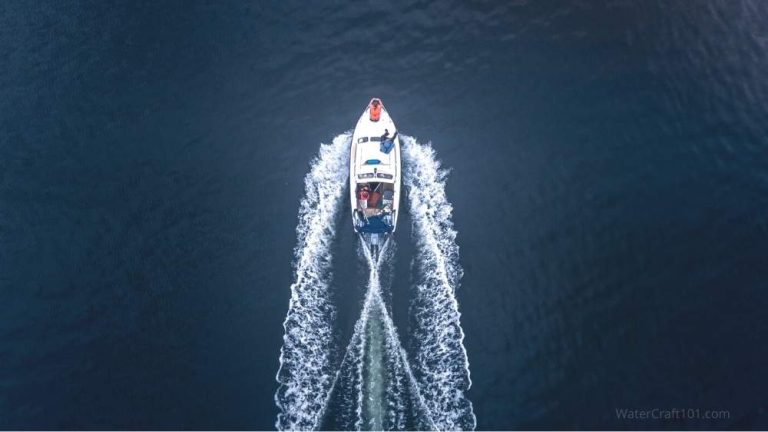
How to Trim a Boat Like a Pro (Beginners Guide)
Properly trimming a power boat can help you adjust the stern and bow in such a way as to significantly affect the boat’s speed, fuel economy, and overall performance. It’s all about physics, as a properly trimmed boat can help you glide on the water more efficiently. However, a lot of beginning boaters want to…
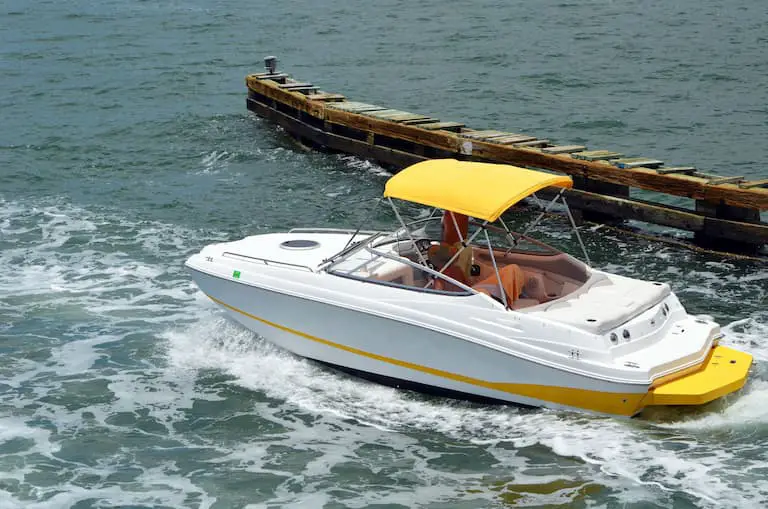
10 Reasons Why Inboard Boats Are So Expensive
If you’re looking to buy an inboard boat, you might have noticed that they’re much more expensive than outboard boats, I/O boats, and regular stern drives. The cost difference is quite significant compared to boats with similar motor sizes and capacities. So, why are inboard boats so expensive? Here are 10 reasons why inboard boats…


Service Locator
- Angler Endorsement
- Boat Towing Coverage
- Mechanical Breakdown
- Insurance Requirements in Mexico
- Agreed Hull Value
- Actual Cash Value
- Liability Only
- Insurance Payment Options
- Claims Information
- Towing Service Agreement
- Membership Plans
- Boat Show Tickets
- BoatUS Boats For Sale
- Membership Payment Options
- Consumer Affairs
- Boat Documentation Requirements
- Installation Instructions
- Shipping & Handling Information
- Contact Boat Lettering
- End User Agreement
- Frequently Asked Questions
- Vessel Documentation
- BoatUS Foundation
- Government Affairs
- Powercruisers
- Buying & Selling Advice
- Maintenance
- Tow Vehicles
- Make & Create
- Makeovers & Refitting
- Accessories
- Electronics
- Skills, Tips, Tools
- Spring Preparation
- Winterization
- Boaters’ Rights
- Environment & Clean Water
- Boat Safety
- Navigational Hazards
- Personal Safety
- Batteries & Onboard Power
- Motors, Engines, Propulsion
- Best Day on the Water
- Books & Movies
- Communication & Etiquette
- Contests & Sweepstakes
- Colleges & Tech Schools
- Food, Drink, Entertainment
- New To Boating
- Travel & Destinations
- Watersports
- Anchors & Anchoring
- Boat Handling
Types of Powerboats and Their Uses
Advertisement
What Is An Outboard Runabout?
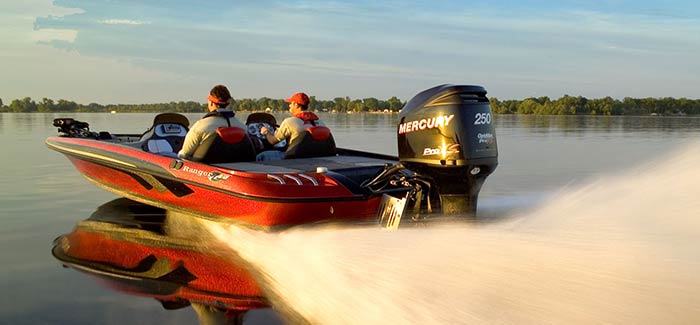
Bass boats are generally 14' to 23', and typically used for freshwater fishing. They have low freeboard and a V hull. They are specialized for bass fishing on inland lakes and rivers. Due to the special gear, high horsepower outboards and trolling motors they are a relatively high price point.
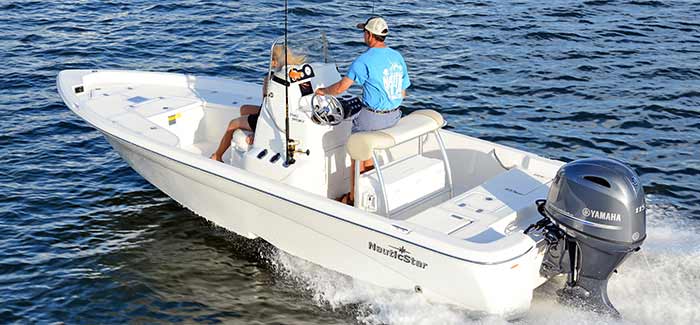
Bay boats have a low profile. They are designed for use in shallow waters of large shallow bays, estuaries or near shore. Bay boats are 18'–24' in length and are fiberglass because they are used in salt or brackish waters. They have more freeboard than a flats boat.
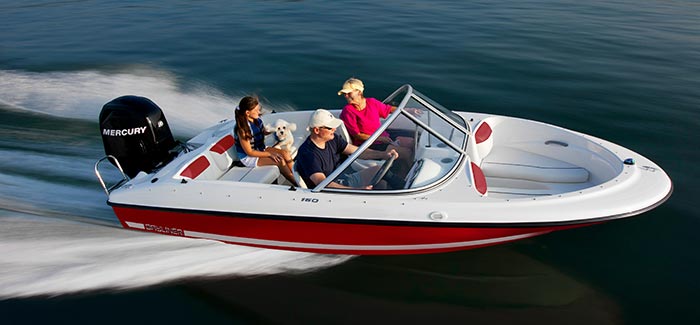
A bowrider has an open bow area designed for extra seats forward of the helm. Bowriders are usually 17'–30'. They are powered by either stern drive or outboard engines. Considered a family boat and can be used for fishing and water sports. A good choice for those new to boating.
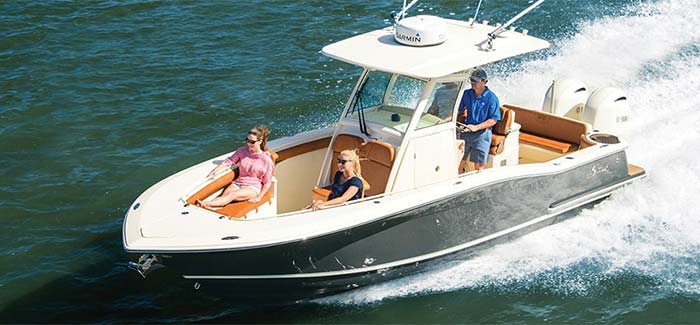
Center Console
Center console boats are from 13'–45'. They are so-named because their helm is on a console in the center of the boat. Like walkarounds, the open hull helps anglers walk from bow to stern without having to navigate around the console. Most use outboard motors for propulsion and the larger size boats are suited for offshore fishing.
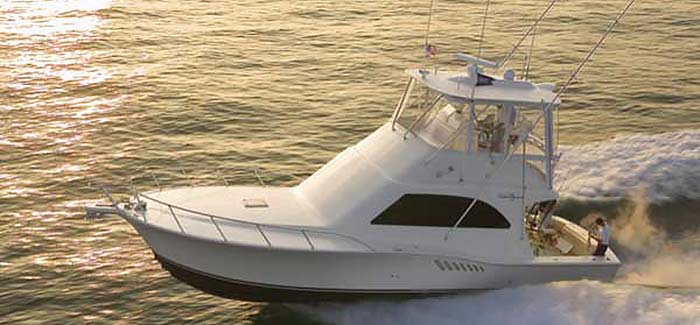
Convertible Fishing Boat
Convertibles are 35 foot and greater boats suited for offshore fishing and cruising. They have large cabins, galleys and berths and are perfect for pleasure cruises and offshore fishing. The flybridge with elevated helm helps to spot flotsam or fish. They have a large fishing deck aft.
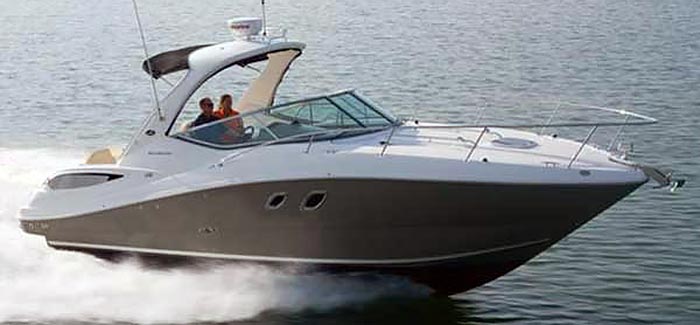
Cruisers are from 21'–45' in length and have a cabin in the bow of the boat. Cruiser cabins are designed for an overnight stay and are typically large enough for a small galley, several berths and an enclosed head.
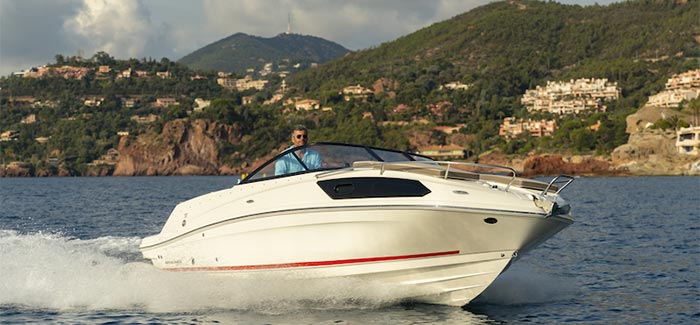
Cuddy Cabin
Cuddy cabin boats have a small cabin for storage or a small seating area. They may accommodate a berth and or head. They are usually about 22–30 feet in length.
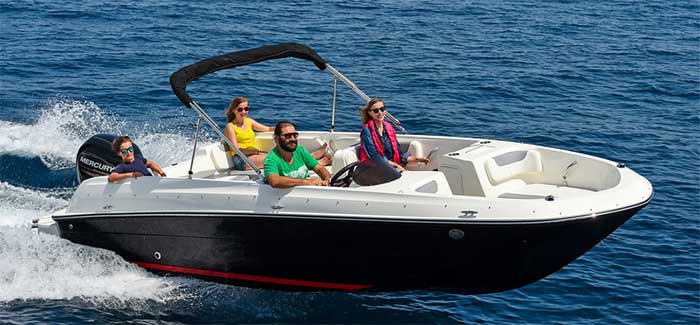
Deck boats have a wide beam and feature a V-shaped hull which offers more performance than a pontoon boat. Featuring an open deck with plenty of seating for parties or family. Used for swimming and water sports. They are outboard or stern drive powered and can be aluminum or fiberglass. These boat are about 25–35 feet long.
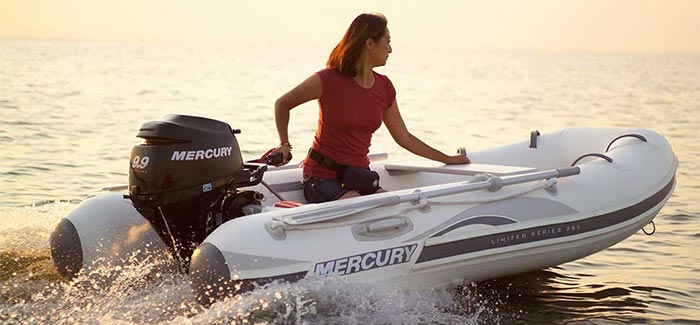
A dinghy is a small boat, usually 7–12 feet in length. They are usually powered by oars, small outboards, or sails. Often carried or towed by a larger boat for going ashore. Low cost and an excellent choice for those new to boating.
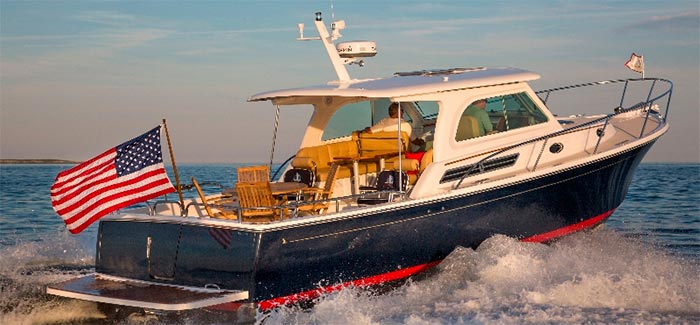
Downeast Cruiser
These boats are native to coastal New England. Also called lobster boats, they are built for offshore cruising and fishing. They have a cabin with berths and a head and dining area.
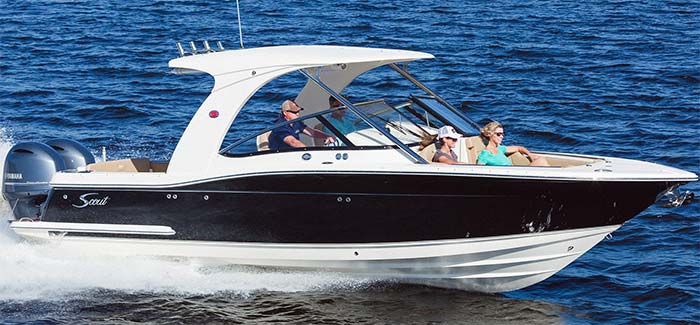
Dual Console
Dual Console boats have two dashboards and windshieldswith space to walk between them for allowing access to the bow area for seating and/or fishing. Lengths run 16–30 feet.
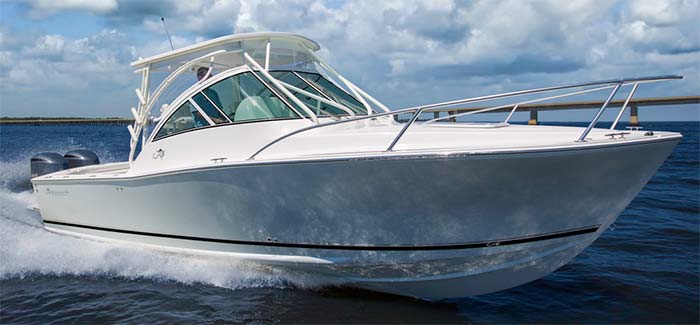
Express Fisherman
The Express Fisherman is designed for high speeds to get to offshore fishing spots in a hurry. They are rigged for offshore fishing. They have large open cockpits and fish fighting areas aft. They usually have limited cruising accommodations but can provide overnight shelter.
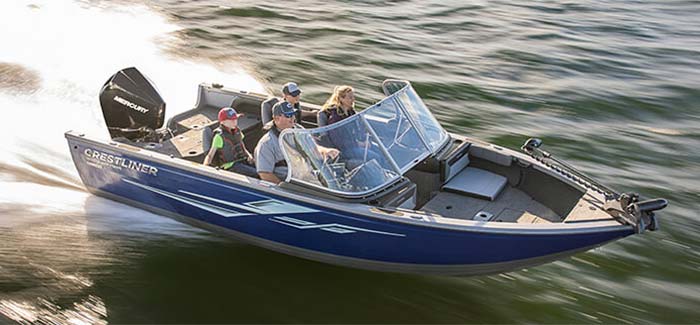
Fish 'n Ski Boat
Fish 'n Ski boats are used for fishing or skiing. These are family boats. They have accessories for each application. They feature comfortable seating and offer livewells and tie downs for rods and have removable, elevated tow bars and ski lockers. They are usually 16–24 feet in length.
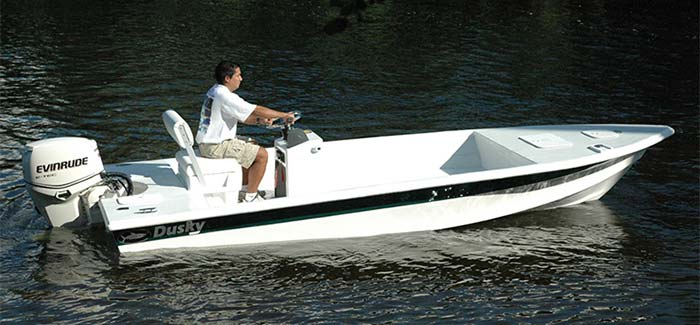
Flats Boats range from 14 feet to 18 feet and are specifically designed to navigate shallow waters needing extremely shallow drafts. A push pole is used to navigate the shallow water.
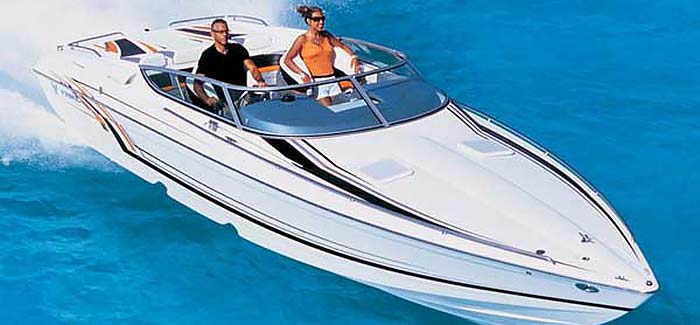
High Performance Boat
Performance powerboats are built for speed, featuring narrow beam, steep deadrise, and high power to weight ratios. They have Spartan cabins. Cockpits seat 2–6 passengers. Powered by high horsepower outboards, stern drives or surface drives, these boats are carefully designed to be fast, light and strong, ideal for racing or fast cruising. They range from 25–60 feet in length.
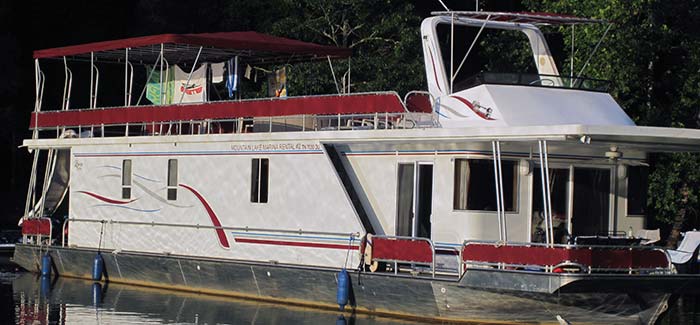
As the name implies houseboats are floating houses. They are either outboard or inboard propelled and range from 25 to 150 feet in length. Just like a house they have full kitchens, bedrooms and living and dining areas. They are the ultimate family boat. They are generally found on quieter bodies of water since they have low freeboards and are built on a barge-like hull.
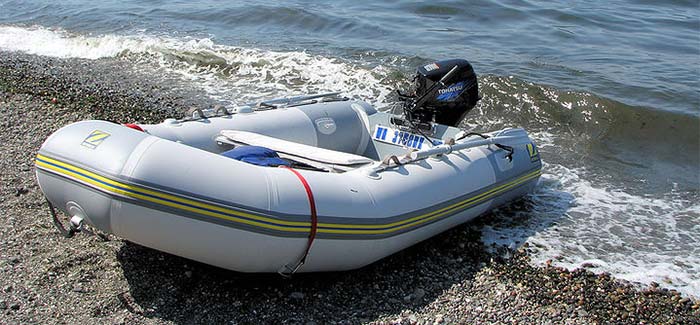
Inflatable Boat
Usually 6'–14' in length and have inflatable tubes for their sides. The floor is flexible or made rigid using plywood or aluminum floorboards depending on the size. Outboard motors can be used on the rigid transom. They deflate and are easy to transport or store. Used as dinghies on larger boats. A good choice for those new to boating.
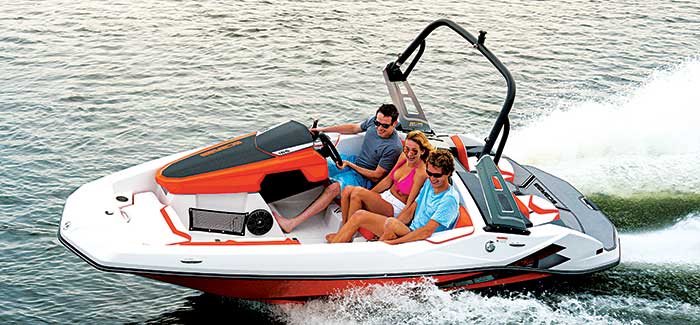
Jet Boats have single or multiple jet drives instead of a propeller for propulsion. They are very maneuverable. These smaller boats (14–24 feet) are generally used for water sports and getting into shallow waters.
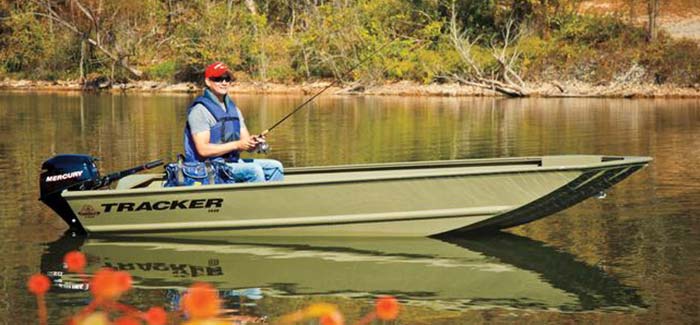
Jon boats are small utility craft primarily used for boating in shallow water. They range from 10 to 18 feet in length. They can be made of aluminum or fiberglass. They are inexpensive and a good choice for the novice boater.
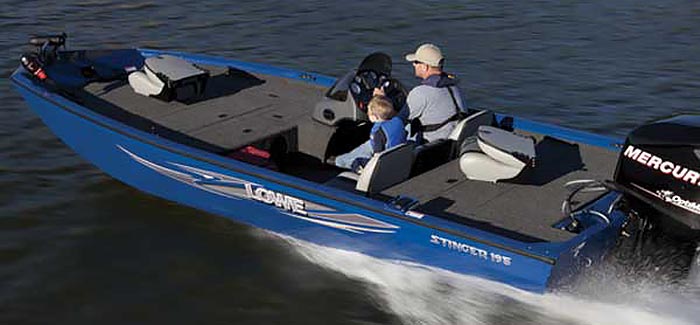
Multi-species Boat
Multi-species boats are 17–23 feet in length. They are made of fiberglass or aluminum. They are designed to travel in rougher water than bass boats. As the name implies, these boats are made for fishing a variety of different fish in all types of water.
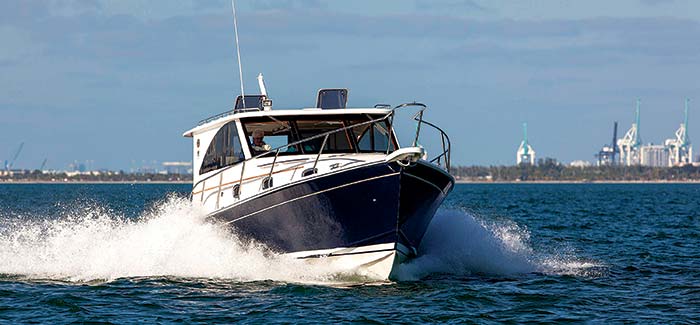
Pilothouse Boat
Featuring a fully enclosed pilot house, these boats are built to ride rougher seas while keeping helmsman high and dry. They are powered by outboards, stern drives or inboards. They are popular for cruising and many types of fishing. They usually have a berth and a head. They are usually 20–35 feet in length.
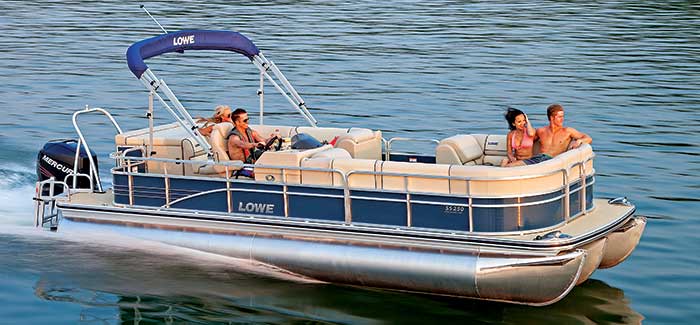
Pontoon Boat
Pontoon boats have 2 or 3 aluminum tubes that support a broad platform. They have shallow drafts and are very stable. They are usually found on inland lakes and rivers and other small bodies of water. Used for cruising, fishing and water sports. Powered by an outboard or stern-drive. Lengths from 15–30 feet.
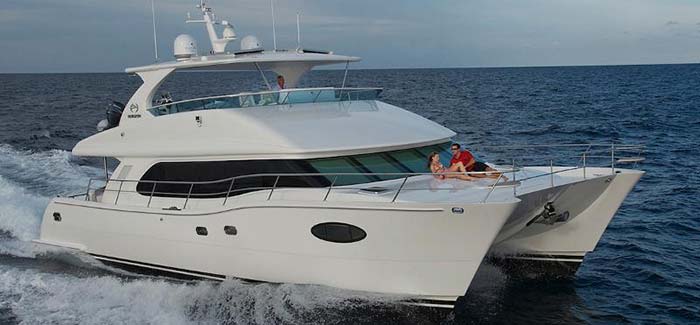
Power Catamaran
These dual-hull boats are generally used for offshore fishing. They are more rugged, provide a more stable ride, faster speeds and better fuel economy than mono-hulls. They are 25–40 feet in length.
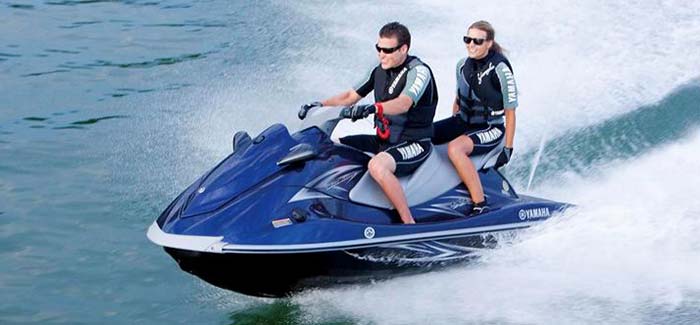
PWC (Personal Watercraft)
Entry level boats that are fun to drive and economical to buy. They come in lengths from 9–14 feet. They are usually built for 1 or 2 people but larger, more powerful models can seat up to 4. They are powered by jet drive.
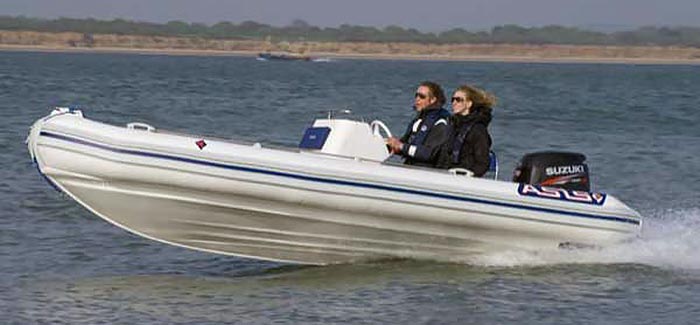
Rigid Inflatable
RIBs (rigid inflatable boat)s have a fiberglass or aluminum hull attached to inflatable outer tubes. Outboard motors are used on the transom for power. RIBs are usually faster, larger, and can carry more weight than flexible floored inflatables. They also come in larger sizes.
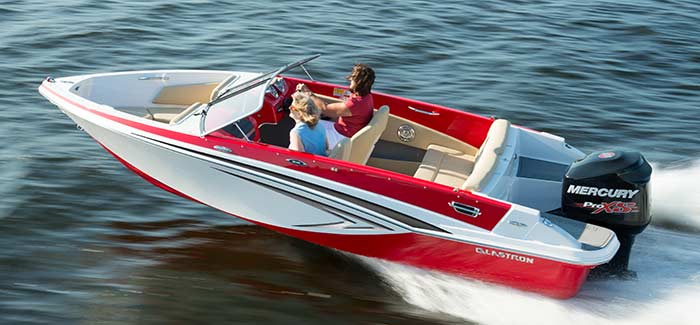
Many boats are called runabouts. Generally a runabout is defined as a small powerboat somewhere in the 14–24 foot range. They are usually powered by an outboard or stern-drive engine. They are a multipurpose boat suitable for water sports, cruising and fishing.
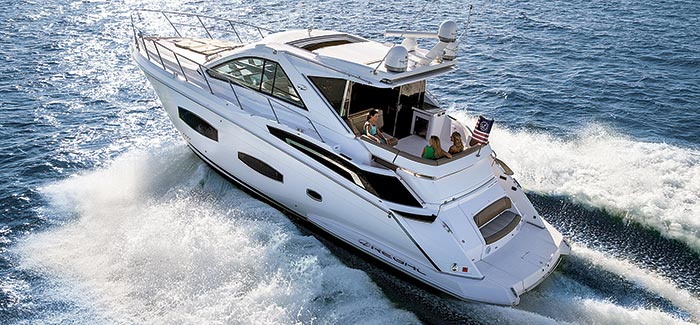
Sedan Bridge Boat
Intended for extended cruising with accommodations down below to suit long stays on the water. They range from about 35–65 feet. The bridge positions the helmsman high above the water allowing for great visibility.
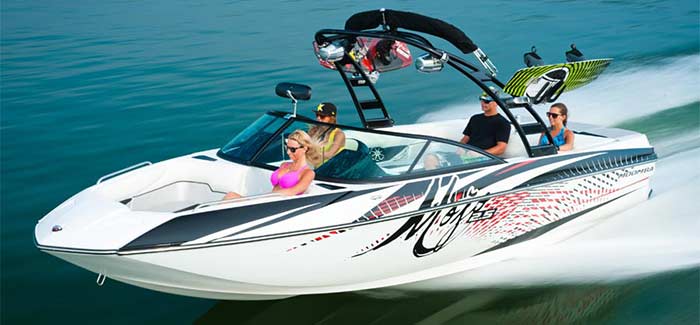
Ski and Wakeboard Boat
These boats are designed specifically for water sports. They can be ballasted for producing higher wakes for trick skiing and waterboarding. They are also great for pulling inflatable tubes.
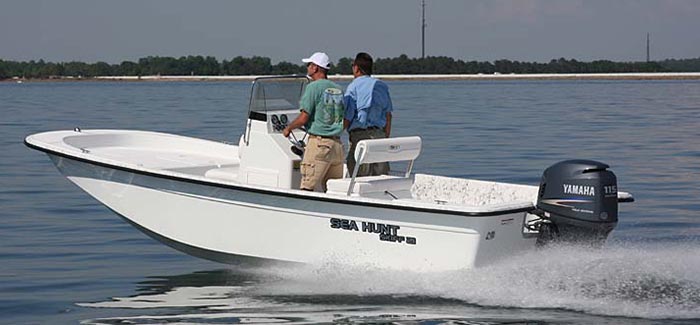
The skiff is similar to a Jon boat. They are another entry level boat. They are especially good for boating in shallow water. The can have flat or cathedral shaped hulls. Many have a console to steer from.
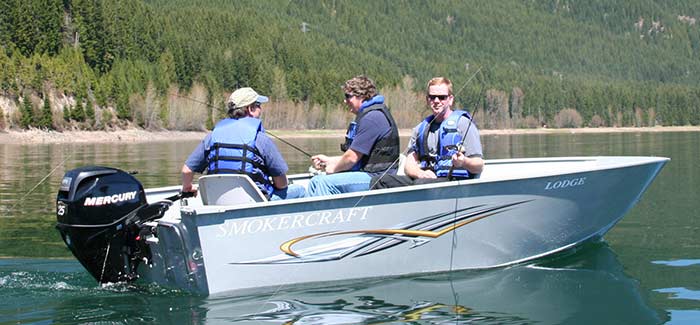
Utility Boat
Utility boats are made for tough use. Generally made of aluminum with outboard power and range from 12–20 feet. Used for fishing or as workboats. Relatively low cost to maintain and a good choice for the novice boater.
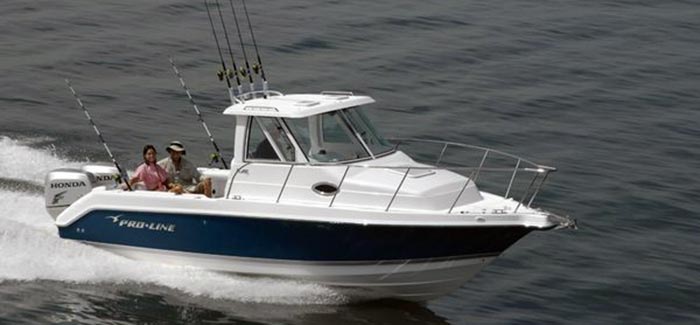
Walkarounds
Walkarounds allow an angler to walk around the cabin. They are generally 20–30 feet in length. They are usually found on larger bodies of water and can be powered by an outboard, Inboard/outboard or inboard engine.
Related Articles
The truth about ceramic coatings for boats.
Our editor investigates the marketing claims of consumer-grade ceramic coatings.
Fine-Tune Your Side Scan Fishfinder
Take your side-scanning fishfinder off auto mode, and you’ll be spotting your prey from afar in no time
DIY Boat Foam Decking
Closed-cell foam flooring helps make boating more comfortable. Here’s how to install it on your vessel
Click to explore related articles
BoatUS Editors
Contributor, BoatUS Magazine
Award-winning BoatUS Magazine is the official publication of Boat Owners Association of The United States. The magazine provides boating skills, DIY maintenance, safety, news and more from top experts.
BoatUS Magazine Is A Benefit Of BoatUS Membership
Membership Benefits Include:
Subscription to the print version of BoatUS Magazine
4% back on purchases from West Marine stores or online at WestMarine.com
Discounts on fuel, transient slips, repairs and more at over 1,200 businesses
Deals on cruises, charters, car rentals, hotel stays and more…
All for only $25/year!
We use cookies to enhance your visit to our website and to improve your experience. By continuing to use our website, you’re agreeing to our cookie policy.

Monaco Historics, ELMS and more coming to MAVTV

By RACER Staff May 3, 2024 9:40 AM
By RACER Staff | May 3, 2024 9:40 AM ET
MAVTV is adding six new motorsport series and events this summer. The latest additions include the 2024 European Le Mans Series, 2024 Michelin Le Mans Cup series, the renowned 2024 Monaco Historic GP, the 2024 DTM (Deutsche Tourenwagen Masters), the 2024 Powerboats P1 Offshore Series, and highlights coverage of the 2024 Toyota GR Cup North America.
“MAVTV is now home to even more racing, and we are thrilled to kick off the summer with an incredible lineup of new content from some of the most dynamic race series throughout Europe and the United States,” said MAVTV President CJ Olivares. “From the thrilling Le Mans series to 1,100hp Powerboats reaching top speeds of 175mph, our lineup is sure to deliver action-packed entertainment, fierce competition and breathtaking finishes. We are proud to keep bringing fans a wide variety of racing; whether on pavement, water or dirt, it’s on MAVTV and we expect to see some unforgettable moments in motorsports this summer.”
2024 Toyota GR Cup North America – Toyota GR86 high-performance race cars compete at seven different iconic road courses across the United States including Circuit of The Americas, Road America, Sonoma Raceway and more. The GR Cup Highlight shows will start airing May 6.
2024 European Le Mans Series – Endurance teams compete to see if they have what it takes to enter the 24 Hours of Le Mans. The series consists of six, four-hour races on some of the most technical and demanding tracks in Europe designed to push the teams to their limits. Forty-two cars will compete in four different classes, and the champions of each class automatically earn a spot in the 24 Hours of Le Mans. Special coverage begins May 9.
2024 Michelin Le Mans Cup – Similar to the ELMS, the 2024 Michelin Cup features 42 drivers in two different classes that compete in six different rounds at historic circuits throughout Europe. Launched in 2016, this series serves as a place for amateur drivers to learn what it takes to be a professional endurance driver. Special coverage of the Michelin Cup begins May 9.
2024 Monaco Historic Grand Prix – The 2024 Monaco Historic GP airing on MAVTV Live, May 11-12, features seven generations of GP cars and several prominent former Formula 1 drivers and sports car champions. The event is held on the same historic downtown circuit as F1’s Monaco GP and is virtually unchanged since the first races were held in the 1950s. This storied race began as a one-time event to mark the 700th anniversary of the Grimaldi family’s rule in Monaco. Due to its popularity, it was decided to hold the race every two years starting in 2000. Live coverage of the biennial event begins May 11.
2024 DTM (Deutsche Tourenwagen Masters) – This series began in 1984 and while it has gone through some changes over the years, it is now known as the home for premier GT3 racing with cars from top European automakers including Audi, BMW, Mercedes, Ferrari and more. While the vehicles are high-performance race cars, they still resemble models available to consumers. The 2024 season features eight races at legendary circuits like Germany’s Nürburgring and the Red Bull Ring in Spielberg, Austria. The race season kicked off April 25 and wraps up Oct 20. Replay coverage of DTM begins May 16.
2024 Powerboat P1 Series – All new to MAVTV, this popular race series features some of the world’s biggest and fastest race boats, with some capable of speeds of 160mph or more. The 2024 season kicks off the weekend of May 16-19 with the “Thunder on Cocoa Beach” which is the 15th anniversary of that event. The series then heads to the Lake of the Ozarks, Mo., Sheboygan, Mich., Sarasota, Fla. before wrapping up at St. Petersburg, Fla. on Sunday, Oct. 20. Catch live coverage of the events beginning May 19.

MAVTV , Industry
F1 TV PRO | MIAMI GP

LATEST NEWS

Heim fights through handling woes to win Truck Series at Kansas

Three classes of IMSA teams headed for Laguna Seca

The RACER Mailbag, May 1

NASCAR 1hr ago
Corey Heim took control of Saturday night’s Heart of America 200 in the final stage and charged to his second NASCAR CRAFTSMAN Truck (…)

NASCAR 5hr ago
Bell romps to his first pole of the season at kansas.
Christopher Bell won the pole for the NASCAR Cup Series race at Kansas Speedway with a qualifying lap of 183.107mph (29.491s). It is Bell’s (…)

Formula 1 5hr ago
Leclerc looks to pressure verstappen during miami gp.
Charles Leclerc believes his performance in the sprint shows he is likely to be able to put Max Verstappen under pressure in Sunday’s (…)

Formula 1 6hr ago
Sprint result 'middle fingers up' for ricciardo despite q1 exit.
Daniel Ricciardo says his top four finish in the sprint let him put a “couple of middle fingers up” to critics even though he then (…)

NASCAR 6hr ago
Reddick fastest in saturday's cup series practice at kansas.
Tyler Reddick paced Saturday’s NASCAR Cup Series practice at Kansas Speedway at 181.002mph (29.834s). Reddick is the most recent winner at (…)

Alonso claims Spanish drivers being treated differently by FIA
Fernando Alonso has claimed Spanish drivers are being treated differently by the FIA after a lack of a penalty for Lewis Hamilton at (…)

Johnson and Legacy MC all benefitting from more seat time
Jimmie Johnson will run his third NASCAR Cup Series race in the last four weeks Sunday at Kansas Speedway in the No. 84 Legacy Motor Club (…)

Formula 1 7hr ago
Verstappen cruises to sweltering miami gp pole ahead of leclerc.
Max Verstappen has pipped Charles Leclerc to pole position for the second time this weekend for tomorrow’s Miami Grand Prix. The (…)

NASCAR 7hr ago
Gragson eager for 'mile-and-a-half season' for the first time.
Noah Gragson sees a month of opportunity ahead for his Stewart-Haas Racing team. “For the most part, I’m really happy with our (…)

Formula 1 11hr ago
Magnussen says hulkenberg didn't play team game in miami sprint.
Kevin Magnussen says his multiple penalties in the sprint at the Miami Grand Prix were justified as he protected Nico Hulkenberg, but felt (…)
- Follow us…
- USF Pro Championships
- Team USA Scholarship
- Xfinity Series
- WeatherTech Sportscar Championship
- Michelin Pilot Challenge
- Ferrari Challenge
- Mazda MX-5 Cup
- Porsche Carrera Cup North America
- Radical Cup
- Supercars Championship
- Vintage Motorsport
- Short course
- EPARTRADE Race Industry Week
- Current Issue
- RACER Magazine Customer Service
- Subscribe to RACER Magazine
- $9.99 Digital Subscription
- Buy Single Issues
- Gift Subscription
- Road to Indy
- GT World Challenge America
- World Endurance Championship
- F4 U.S. Championship
- Newsletter Subscription
- North American Racing
- Skip Barber Racing School
- RACER Stuff
- Magazine Subscription
- Your Privacy Choices
- Racer Studio
- Terms and Conditions
- Privacy Policy
- Cookies Policy
- All contents copyright © 2024, Racer Media & Marketing, Inc. All rights reserved. This material may not be published, broadcast, rewritten or redistributed in any form without prior authorization. Your use of this website constitutes acceptance of our Privacy Policy and Terms & Conditions. Racer Media & Marketing, Inc., 2525 Main St, Ste 430, Irvine, CA 92614, 949.417.6700 Partner of USA Today Sports Digital Properties
- Powered by WordPress VIP

F1’s Miami GP leaned into the ‘joke’ with its fake marina — and created a symbol

MIAMI GARDENS, Fla. — Walk through Gate 9, over the Turn 6 bridge, across a short fan zone, and you will encounter a vibrant, eye-catching aqua blue. The surface is smooth and serene. Four yachts are docked on it, all surrounded by a lovely marina.
A picturesque environment. The kind that makes you feel like you could be in a tropical oceanside setting — except for one notable thing.
Advertisement
While the yachts are real, the water they “float” on is fake. Plywood is laid down and then covered in blue vinyl material, complete with waves and ripples designed into the covering to create the impression that the yachts are floating. Thus, the Miami Grand Prix appears to have a waterfront backdrop despite being located in Miami Gardens at the landlocked Hard Rock Stadium, also home to the NFL ’s Miami Dolphins.
“We joke about this a lot internally,” said Tyler Epp, Miami Grand Prix’s president, according to Business Insider. “We never took ourselves too seriously with the marina. We’re not sitting on the Pacific Ocean or the Red Sea like the Formula 1 race in Jeddah, Saudi Arabia. But Miami is so much about boats, beauty, culture — and credit to the team, who wanted to create an opportunity for people to experience that in a unique way.”
Dolphins owner Stephen Ross and club CEO Tom Garfinkel originally envisioned the Miami Grand Prix in downtown Miami. Had this plan come to fruition, the scenic waterfront setting indelibly linked to Miami would’ve occurred naturally. However, pushback from city officials scuttled those plans, necessitating a Plan B.
And just like that, the idea of racing along the ocean vanished with the shift to Hard Rock Stadium. After all, it’s hard to showcase the ocean when the Atlantic is several miles away.
“We have been very committed to, from the beginning, the brand of Miami,” Miami Grand Prix president Tyler Epp said in 2023. “We’re going to create Miami as the lens for which people are viewing the race.”

Thus, the idea was born to create the kind of visual associated with South Florida by creating a replica marina, complete with a yacht club. In the third year of the Miami Grand Prix, the setting inside Turns 6, 7 and 8 has become an identifying symbol linked to the race.
Organizers admit the setting is tongue-in-cheek. Since being publicly unveiled in 2022, the marina has been subject to plenty of jokes and memes across social media. But they, and those partaking in the revelry in the marina, will tell you that’s OK. What has been created is a fun atmosphere that accomplishes the goal of giving the circuit as close to an authentic “Miami feel” as it can despite the obvious restrictions.
“This is as unique a viewing experience as you’re going to find,” said Harris Glaser, president of Midnight Express Powerboats, who’s purchased two of the four available slips. “And, honestly, when you’re up top and look down, it does look like water. The dock aesthetic helps, too.”
As Glaser speaks, qualifying for Saturday’s sprint race is underway, with cars buzzing through every few seconds. Not that too many folks seem to be paying close attention. The on-track action is secondary — at best.
Instead, most seem to enjoy the festivities on this sunshine-baked afternoon.
On the other side of the “water,” a DJ is playing a constant stream of hip hop from 50 Cent (“Just a Little Bit”) to Snoop Dogg (“Drop It Like It’s Hot”) to Lil Jon and The East Side Boyz (“Get Low”) among the rotation. The thumping music compels some attendees to dance on the boat decks. And if you desire an adult beverage, there is no shortage of options as each of the two Midnight Express yachts has assorted bottles of hard liquor and beer on ice.
Spent time waterside at the marina. pic.twitter.com/HDKGh5883V — Jordan Bianchi (@Jordan_Bianchi) May 4, 2024
Even if it’s a facsimile, the vibe still has a very Miami feel—exactly what race organizers pitched Hasler when they approached him about the opportunity three-plus years ago.
With Midnight Express based in Miami and its powerboats appealing to a similar high-dollar consumer that likely would find the Miami Grand Prix’s marina environment appealing, Hessler thought it made sense. He quickly signed on, becoming the first to do so. He politely declined what he paid to have two of his boats lifted into the marina to (essentially) serve as suites for him and his guests, but that he’s been doing this all three years indicates he’s found the investment worth it.
“It’s expensive,” Hessler said. “Very expensive.”
Although the “water” may be fake, these boats certainly are not. Both Midnight Express boats are working vessels, each featuring five 450-horsepower engines. On Tuesday, they will be transported from the circuit to a dock in the Atlantic, 10 miles away.
No, the Miami Grand Prix doesn’t abut an actual body of water as initially intended, but race organizers got creative to achieve their objective. And the finished product more than serves its purpose.
“It’s the Monaco experience in Miami,” Glaser said. “It’s pretty incredible to pull something like this off.”
Madeline Coleman contributed to this story.
Top photo: Jordan Bianchi/ The Athletic
Get all-access to exclusive stories.
Subscribe to The Athletic for in-depth coverage of your favorite players, teams, leagues and clubs. Try a week on us.

Jordan Bianchi is a motorsports reporter for The Athletic. He is a veteran sports reporter, having covered the NBA, NFL, Major League Baseball, college basketball, college football, NASCAR, IndyCar and sports business for several outlets. Follow Jordan on Twitter @ jordan_bianchi

COMMENTS
American Power Boat Association. 2701 Lake Myrtle Park Rd. Auburndale, FL 33823. Phone: (586) 773-9700. Fax: (586) 773-6490
Powerboat Basics. Before you're ready to jump in the cockpit and hit the water, some basic education on the ins and outs of powerboats might be helpful, so let's take a look at some of the basics of powerboat racing. To put yourself at the top of the podium, it all starts with understanding your equipment compared to your competitors.
Fast Starts Serve U.S. Well at World Championships. The APBA is the foremost sanctioning body for power boat racing in the United States. Stay up to speed on news, upcoming races, race results and standings.
Offshore powerboat racing is a type of racing by ocean-going powerboats, typically point-to-point racing . In most of the world, offshore powerboat racing is led by the Union Internationale Motonautique (UIM) regulated Class 1 and Powerboat P1. [1] In the US, offshore powerboat racing is led by the APBA/UIM and consists of races hosted by ...
Just like other motorsports, the inside lane is the best position in powerboat racing. It provides the shortest distance around the course and gives an advantage to any racer. The overall length of the race is five miles, but depending on the size of the course, the number of laps may vary from three to five total laps for a complete race. ...
The racing craft is lifted just above the water by forcing air underneath the bottom and trapping it between the outside sponsons (think catamaran hull design). This surface-skimming ride and the incredible horsepower-to-speed ratio push Newton's fundamental law of gravity to the outer limits, giving the driver an unparalleled aerodynamic ...
The sport of powerboat racing has been around for over 100 years with popularity worldwide. The powerboat, which can also be called a motorboat or speedboat, is powered by an engine which allows for high performance speeds. It is one of the most popular forms of boat racing, with multiple international events annually. Table of Contents.
On October 10th, 2020 a revised version of the historic offshore powerboat race known as the "Rum Run" took place off the coast of Southern California. Produ...
Racing is still in the blood as her daughter Laura and granddaughter Lucci are both keen powerboat racers. Buzzi's legendary status stems from 40 years of work in the marine industry. 5. Powerboat designer Fabio Buzzi. The late Fabio Buzzi is a legend, both behind the helm and at the drawing board.
P1 Offshore is an organisation responsible for a series of world-class powerboat racing competitions. P1 Offshore is operated by Powerboat P1. Classes include: Class 1, Supercat, Superstock, VX, Stock V, Mod V and Bracket Classes 100 - 700 . P1 Offshore is partnered by the American Power Boat Assocation (APBA), Mercury Racing and the Offshore Powerboat Association (OPA)
Offshore. APBA Offshore racing features some of the biggest and fastest boats around. These Mega-horsepower catamarans and V-hulls are capable of speeds up to 180 MPH. The teamwork and professionalism of Offshore racing make it a class act and a thrill for spectators. Typically, a team of one driver and one throttleman battle the wind and waves ...
Powerboat racing is more than just showing up and dropping a boat in the water. Besides high-powered engines, major racing skills and nerves of steel, there are countless details to consider ...
Class 1 is the premier category of international offshore powerboat racing. A P1 Offshore event can include a number of classes, but only the Class 1 Championship is sanctioned by the UIM (Union Internationale Motonautique), the world governing body for all powerboating activities. Basic rules for Class 1 dictate a minimum boat length overall ...
Powerboat P1 is the fastest growing marine motorsport series in the world and has a long term commitment to growing and developing the sport of power boating...
The oldest saying in offshore powerboat racing is "to finish first, first you have to finish," and that couldn't have proven truer as the favorites in Super Stock and Bracket 500 succumbed well before the checkered flag waved on the first day of action at the 39th annual Sarasota Powerboat Grand Prix in Sarasota, Fla. Produced by Powerboat P1, the Grand Prix is the third race of the ...
Fact #10: Racing Powerboats Are Fast Enough To Make F1 Race Cars Look Slow. A Formula 1 powerboat has supreme speed with a very fast acceleration, making the F1 powerboat unrivaled in both water and motorsport. This racing powerboat can even make an F1 race car with a top speed of 160kph look sluggish.
In the United States, powerboat racing got its big start on Long Island Sound. Here again, speeds were glacial compared with modern performance boats, but it did mark the beginnings of the sport. One event began in 1959, the "Marathon Around Long Island," and is still held by the National Powerboat Association.
Inboard racing requires an unmatched level of teamwork and professionalism, as well as a family atmosphere with life long bonds between owners, drivers and crew members; and that is exactly what powerboat racing is all about. Inboard racing classes consist of both Runabout and Hydroplane classes. You can tell a boat's class by the letter (s ...
Believe it or not, Martin—a retired offshore powerboat racing world champion—works with more experienced go-fast powerboat operators than rookies. (As noted at the outset of this article, pretty much no one starts with a high-performance V-bottom or catamaran.) While owners of new go-fast cats and V-hulls can pay renowned experts like John ...
Performance powerboats are built for speed, featuring narrow beam, steep deadrise, and high power to weight ratios. They have Spartan cabins. Cockpits seat 2-6 passengers. Powered by high horsepower outboards, stern drives or surface drives, these boats are carefully designed to be fast, light and strong, ideal for racing or fast cruising.
"MAVTV is now home to even more racing, and we are thrilled to kick off the summer with an incredible lineup of new content from some of the most dynamic race series throughout Europe and the United States," said MAVTV President CJ Olivares. "From the thrilling Le Mans series to 1,100hp Powerboats reaching top speeds of 175mph, our lineup ...
More than most categories, racing Unlimiteds requires teamwork. The talented driver is the star, of course. However, it takes a dedicated owner, skilled crew chief and an entourage of engine/hull/transport specialists to make a champion. This is the ultimate in powerboat racing, and it's a worldwide phenomenon.
MIAMI GARDENS, Fla. — Walk through Gate 9, over the Turn 6 bridge, across a short fan zone, and you will encounter a vibrant, eye-catching aqua blue. The surface is smooth and serene. Four ...
The K PRO Hydro class is a class for kids only. The OSY400 class is the USA version of the largest UIM powerboat racing class in the world. K PRO Hydro and OSY400 are restricted to gasoline and oil fuel. The C Service and C Racing classes are based on American built fishing and racing motors from the 1930s to the 1950s.
The Kent Narrows Racing Association (KNRA) applied for a permit under 33 CFR 100.15 to conduct the Harford County Spring Nationals Inboard Hydroplane Race on May 11, 2024, and May 12, 2024, from 10 a.m. to 6 p.m. on both days. The high-speed power boat racing event consists of approximately 60 participating racing boats—including